|
|
|
30 September 08: Football is fun
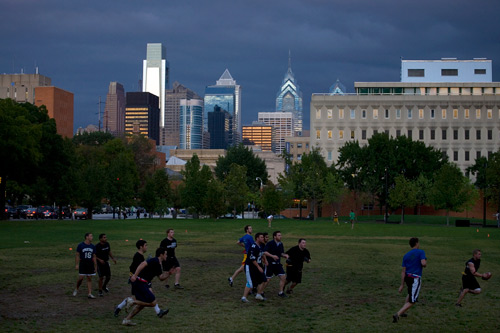
I like it.
And perhaps you do, too. Maybe you should get your boys together and run a game in the park this weekend. Take bets on who pulls a hammy or breaks a nose.
It looks like these boys enjoy their American football too, especially the fellow running the quarterback keeper in for the score during a flag football game
at Hill Field. (Hill Field? Street Road? Apple Store Cherry Hill? What is it with these local names???)
This game was the scene at 34th & Chestnut in West Phil last night, after a daylong gray sky when a sliver of late day shined off the skyline. ISO 500, f4.0,
1/320, no tripod.
UPDATE: Chris from Rittenhouse writes:
The picture from your latest post is of the Penn Law Intramural Flag Football League. They play at the Hill Field, the field
next to the Left Bank and down on Bower Field, under and beyond the train tracks and next to Penn's hockey rink. I'm a retired alum. The league is
surprisingly big (10+ teams) for a relatively small school (700 kids) and unsurprisingly contentious and argumentative for a league composed of future
lawyers. Lots of on-field rule debates.
The dude in the Dallas Jersey wears it to every game and receives much crap for it. Luckily he's terrible and thus doesn't get to do much
shit-talking.
* * *
Ha ha, thanks Chris!
–B Love
|
30 September 08: Methodological madness, or,
OKAY, PHILADELPHIA'S POPULATION
MAY NOT BE INCREASING . . . YET
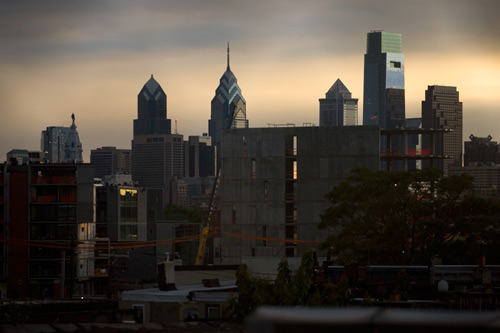
Numbers, numbers, numbers.
When the US Census released its American Community Survey (ACS) last week, the news said that immigration was down. That Philly Skyline proponent of immigration
Nathaniel Popkin went to the source, combed the data, and made an incredible discovery no one
else had picked up on: Philadelphia's population is increasing, reversing a decades long decline.
Could that be? Could our giant rust belt city have finally put a plug of positivity into that drain, a Nutter icing on a cake we've been baking in Center City and
its growing extensions in the past 5-10 years? The numbers are right there, right on the Census' web site for the ACS. Click the number in question for the source.
The proof is in the pudding, yeah? The problem -- the conflict -- I've discovered in the days since this revelation (with a hand from a few readers) is from the
Census' official Population Estimates, which show Philadelphia as still on the slow decline.
Date | Philadelphia PA
April 1, 2000 (US Census) | 1,517,550
July 1, 2005 | 1,460,301
July 1, 2006 | 1,453,212
July 1, 2007 | 1,449,634
April 1, 2010 (US Census) | ??? | | | | | |
Comparing the ACS and Population Estimate figures, 2005 is way off, 2006 is pretty close, and 2007 is exactly the same. To understand why, we have to know exactly
what ACS is.
The American Community Survey was developed by the Census in 1996, indirectly an answer to microtechnology, as a matter of improving Census data and its timeliness,
and for indicating local and national trends. The project was under testing and development through 2004 and finally rolled out in 2005 for counties over 65,000,
including Philadelphia. Questionnaires address things like age, income, language, disability and so forth. Administered by regional Census offices, the data is
collected via mail, telephone and computer.
 The 2005 ACS being the first implementation, one is willing to give the Census a pass, to allow a margin of error and find the kinks to iron out. Still, 40,000+ is
a pretty big discrepancy. Census statistician and ACS specialist Pamela Klein explains, "that first year, we didn't have the funding to calculate controlled
population," or those in group quarters: college dormitories, group homes and prison.
The 2005 ACS being the first implementation, one is willing to give the Census a pass, to allow a margin of error and find the kinks to iron out. Still, 40,000+ is
a pretty big discrepancy. Census statistician and ACS specialist Pamela Klein explains, "that first year, we didn't have the funding to calculate controlled
population," or those in group quarters: college dormitories, group homes and prison.
ACS' 2006 data was the first to include that controlled population, so the Philadelphia figures are pretty close, less than 5,000 difference. That's still a bit of
wiggle room when you consider 2007's figures match. Census mathematician Mark Asiala says, in so many words, that while the Census certainly strives for accuracy,
the ten year censuses are still the best, but that intercensal figures are getting better every year.
"The Population Estimates use the best files and most modern methodology available," he says. "They're also revised every year, [into] what we call 'vintage'
statistics." The vintage statistics are those you see in the Estimates, refined with additional data -- like that from ACS, which uses a different methodology --
compiled in the time between the estimates. When I asked him if that meant that the 2007 ACS and Estimate figures would no longer match when the 2008 figures come
out, he said yes. I can't begin to explain the methodologies, but each is online: ACS methodology & Population Estimate methodology.
Basically, what we can take from this is that the American Community Survey is best for studying trends, while the official Census is the best place for the hard
numbers for the pissing matches between places like Philadelphia and Phoenix.
Greg Heller, the DVRPC planner mentioned last week, has said, "I am tired of comparisons to
Phoenix. There is just no sense to it. When you look at city versus metropolitan numbers, the irrationality of comparing these places becomes abundantly clear."
| City of Philadelphia | City of Phoenix
| 142 sq mi* | 475 sq mi
| 1,456,350 projected population | 1,461,575 projected population
| * * * | * * *
| | Philadelphia MSA | Phoenix MSA
| 5,118 sq mi | 14,573 sq mi
| 5,823,233 population | 3,715,360 population | | | | | |
* - Figures are from DVRPC's GIS shape file data. Philadelphia's area includes waterways in the calculations, which is why it is 142 sq mi instead of the widely
accepted 135. As well, Phoenix's 475 sq mi is from the last official census, as opposed to the 517 quoted from Phoenix's municipal government web site last week.
Also worth noting here is that DVRPC has its own data analysis comparing the Census with the ACS, online HERE.
Heller elaborates, "citywide population numbers are totally useless, except in terms of the city's national image. What matters is whether there are a significant
number of neighborhoods gaining population, and in Philadelphia there are. . . . [But] it would be nice if we could shift the national perception that Philadelphia
is on the decline."
* * *
The improving ACS and the weight given it by the Census Bureau do underscore our Information Age. The monthly-collected, annually-released ACS and the traditional,
decennial Census will eventually merge. By the time they do, there will probably be blogs with countdowns pitting Philadelphia against San Antonio and columns in
each city's newspapers mocking the other. Hell if the Census wanted to get Google involved, the data could probably stream in real-time, never mind monthly or, how
antiquated, every ten years.
It's funny to consider that the Census' conduction every ten years is a matter of the original draft of the Constitution, that it does have bearing on
policy. From Article I, Section 2 of the
US Constitution, written somewhere near 5th & Chestnut:
Representatives and direct Taxes shall be apportioned among the several States which may be included within this Union, according to their respective Numbers, which
shall be determined by adding to the whole Number of free Persons, including those bound to Service for a Term of Years, and excluding Indians not taxed, three
fifths of all other Persons. The actual Enumeration shall be made within three Years after the first Meeting of the Congress of the United States, and within every
subsequent Term of ten Years, in such Manner as they shall by Law direct.
Count your white indentured servants fairly, never mind the untaxed savages, and pad your counts with an additional 3/5ths per negro, OK? What your count adds up to
will determine your Congressional Apportionment,
your number in the House of Representatives. In that 1787 writing, only Massachusetts had as many -- eight -- Reps as Pennsylvania. After the first Census in 1790,
PA had 13 Reps while Mass gained another, at 14. Pennsylvania peaked at 36 in the roaring twenties; now, we have 19.
It's possible that number could go down after the 2010 Census, too, as it has done every Census
since 1930. If it does, and if -- when -- Philadelphia's population is revealed at yet again a number less than the previous Census, the Congressional redistricting
may very well happen here.
The good news is that the 2010 population might not be as low as we'd have predicted in 2000. In fact, the 2006-2007 Estimates difference, a loss of 3,578, is the
smallest of all available figures this decade. We're almost there. In Rizzo's 70s, anyone who said Philadelphia would stop losing people and actually return to
adding people would have been crazy. By 2010, they might be right.
–B Love
|
29 September 08: PNB to remain on yr Citi skyline,
The Spectrum will NOT remain on yr Citi skyline
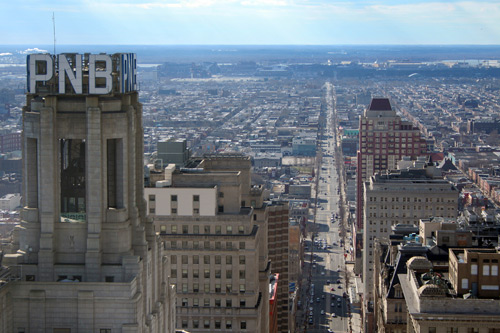
Well then, never mind about that Wachovia sign, the one the Art Commission approved before it approved the Unisys sign. FDIC's approval of
Citigroup's purchase of Wachovia this morning pretty much puts an end to the plans to replace the PNB sign with Wachovia's wavy logo.
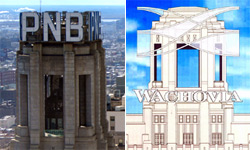 While I think a very strong case can, and should, be made to preserve the PNB letters -- in spite of their non-existence since PNB became CoreStates in the 80s -- I
have to admit that the Wachovia proposal was at least good looking. But all of that is now moot, I suppose.
While I think a very strong case can, and should, be made to preserve the PNB letters -- in spite of their non-existence since PNB became CoreStates in the 80s -- I
have to admit that the Wachovia proposal was at least good looking. But all of that is now moot, I suppose.
Given that Citi's takeover of Wachovia's banking operations happened just this morning, it seems unlikely they'll have any plans to replace that PNB sign with a
Citi logo any time
soon. And while this automatically makes Citi the largest bank in Philadelphia, the hit to Wachovia will hurt the Charlotte community harder than it will us. Check
out the reactions at the Charlotte Business Journal.
What will die in Philadelphia, though, is Wachovia's branding. Never minding the failed PNB sign replacement, it has a huge logo on the east and west sides of their
building at 5th & Market (which barely had any operations -- most of those were in the PNB Building), it has its name on the enormous office building at 123 South
Broad, and, most obviously, the Wachovia Center and Wachovia Spectrum will get a name change.
Well, the Center will anyway, since the Spectrum is coming down. Citi Center? It's not bad, but it sounds an awful lot like Citi Field, the name of the new ballpark
the baseball team that likes to choke in September will be opening in the spring. Not sure how I feel about the Flyers and Sixers playing in an arena with the same
name as a ballpark housing the Mets . . . but that's business in 2008, I suppose.
About the Spectrum. I simply do not understand why this building has to be demolished. I perfectly understand the drive to create Philly Live, a poorly named but
absolutely needed entertainment complex at Broad & Pattison. If I've said it once I've said it a million times: surface parking consumes well over half of the real
estate at the Sports Complex. There is more than enough room to build ALL of Philly Live without having to tear down a 41 year old arena that means a lot to a city
full of sports fans. Never minding the fact it's still used by the Phantoms, who'll have to relocate, taking away the unique major-minor league team situation in
the NHL, it's just so wasteful.
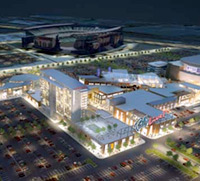 Cordish and Comcast-Spectacor have unveiled their design for Philly Live, including an animated flyover. View the video and other renderings like the one at left HERE. It has the giant atrium leading to the Center that's been featured
prominently in the news, an area tailor made for an ESPN Zone, and a tall new hotel, 15 stories or so. Where the Spectrum stands now? Parking.
Cordish and Comcast-Spectacor have unveiled their design for Philly Live, including an animated flyover. View the video and other renderings like the one at left HERE. It has the giant atrium leading to the Center that's been featured
prominently in the news, an area tailor made for an ESPN Zone, and a tall new hotel, 15 stories or so. Where the Spectrum stands now? Parking.
We've learned
nothing.
Ed Snider, fresh off his stint as Sarah Palin's
personal escort to the Irish Pub, was at Saturday afternoon's pre-season victory over the Hurricanes, talking about how much the Spectrum has meant to him. He's
the one who got it built, after all. (Bill Fleischman has a really nice write-up of the afternoon at philadelphiaflyers.com, HERE.)
He's the one who's tearing it down, too. "I'm telling myself that the great thing about this building is the memories. The memories will never go away," he said.
Nor should a 41 year old building, still in active use, have to. OH WELL. There are still tickets available for next Tuesday's Flyers farewell at the Spectrum, a preseason game against the Phantoms, who will play out the season here
before moving to . . . where?
What's nice about Philly Live is that it has two entrances: one from Broad Street and one from the corner of 11th & Pattison, a direct axis to Citizens Bank Park.
From the subway, though? Enjoy your walk across the surface parking lot, the brand new surface parking lot where the Spectrum once stood.
–B Love
PS: Especially for John and Dawn (and Eric and Kelly), some Spectrum wallpaper.
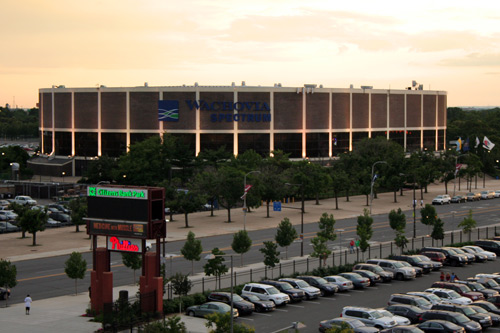
|
29 September 08: Eastern elites
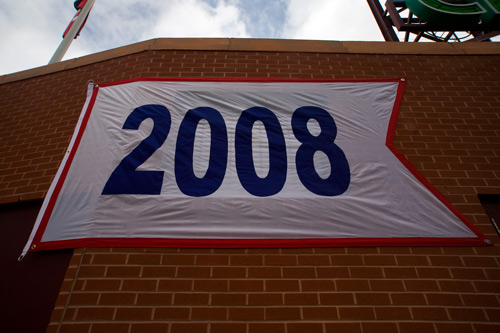
Hot dog, a little slow going on this Monday morning, yessirree. I feel this morning like Jayson Werth must've felt yesterday morning.
What an absolutely superb afternoon in South Philadelphia yesterday. With the Phillies having clinched the NL East on Saturday night, Mark and I headed to Citizens Bank Park for fan appreciation day and what we knew would be the B-team --
nay, future stars -- for the final game of the regular season against a Washington Nationals team who couldn't get it over with soon enough, especially after their
best player grounded into a show stopping double play to end the game the night before. We were almost spot-on for our lineup predictions -- he called Coste at
first, I called Kendrick getting the start, a fine consolation for not making the postseason roster -- but even more fun was trying to call which starter was most
hung over. My thought was that whoever it was would be the first player Charlie called off the bench, so I called Jayson Werth. Spot on.
Even more fun than watching Lou Marson homering in his Major League debut (garnering his first ever Major League "Loooooooooooouuuuuu") and Ryan Howard singling
while extending his ironman streak to 277 games was watching the scoreboard in rightfield. Everyone knew the Mets would blow it -- probably from their bullpen --
but exactly when and how was the question. A lot of people stayed after the game both to get the leftoverswag that ballgirls were tossing into the crowd and to
watch the demise of the Mets. It was beautiful. As with last year, New York's Daily News, Post and Newsday have fantastic photo galleries of facepalms and tears and
general Met anguish. Those are HERE, HERE and HERE, respectively. Even better this year was the
fact that Shea Stadium is closing, so after the emasculating loss that clinched their October golf outings, they had to turn back the tears to feign
celebration.
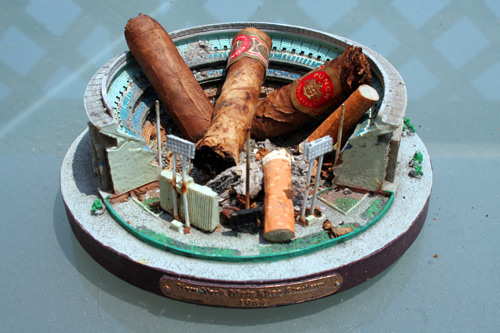
But enough about that. Muck the Fets, it's playoff time.
Wednesday afternoon at 3, the second season starts. There was a huge fan sign in leftfield yesterday reading "WORLD SERIES OR BUST." Right on. The Phillies can do
this thing, they really can. Let's get behind them and see to it that they do.
To send it on home, here are a few Philly Skyline Phillies Skylines from game 162, probably the most fun I've had in a single day at the ballpark all year.
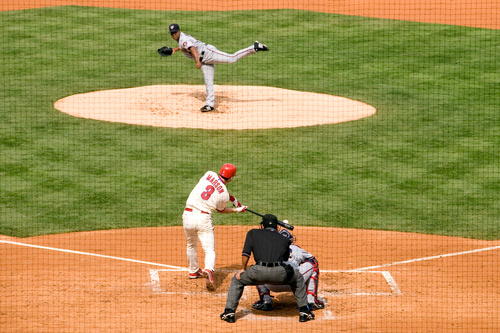
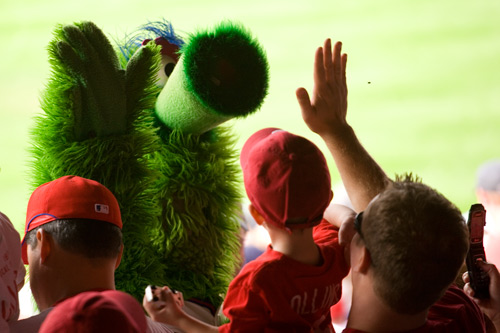
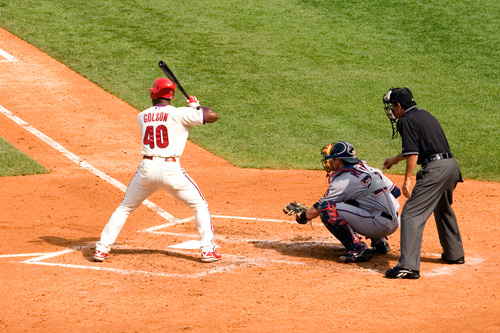
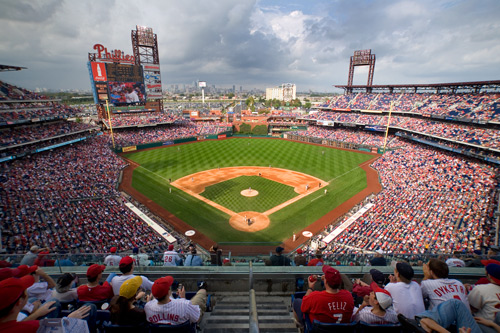
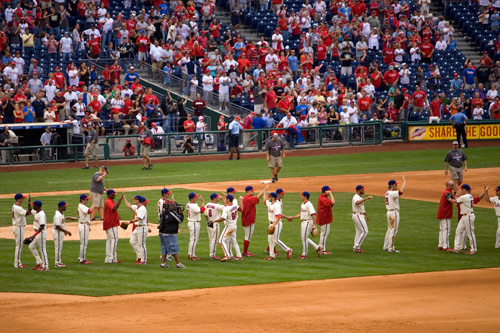
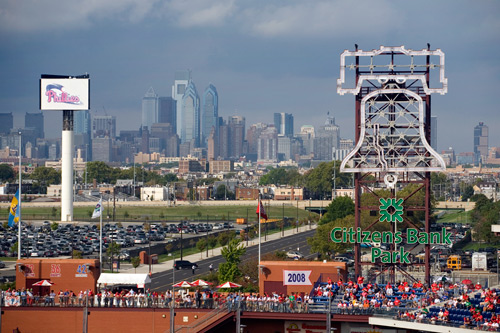
LET'S GO PHILS!
–B Love
|
26 September 08: Stupid Fresh calendar of events

Just some super quick announcements for the marking of yr calendar. (Which reminds me, a 2009 Philly Skyline The Calendar is in the design phase as we speak, so
look for news on that in the coming weeks. Most likely we'll have another party end of November / early December as before.) Anyhoo, get those Sharpies ready . . .
NO REALLY, STUPID FRESH: Our old Philly Skyline friend and official street artist of choice, El Toro, is having a solo show
tomorrow evening. If you've ever wondered who the little blue guy (that's El Toro!) and little yellow guy (that's Bob Will Reign!) are peaking out from the banner
above, or have subliminally become a fan by simply walking around the city with headphones, Saturday is your chance to see this stuff enlarged and in person. El
Toro is hosting a solo show at Abakus in Chinatown, from 6 to 10. Abakus is at 227 North 10th Street, so show some love and stop by for some stickers, if not
t-shirts or prints.
[El Toro 215.]
GREEN ROCKIN' IN PORT RICHMOND: If DJs and graffiti aren't your speed, maybe rock & roll at a bar you've been meaning to
check out anyway will do the trick. Local boy done good and veteran of the Three 4 Tens, Marah and Mondo Topless Jamie Mahon puts his bar on display for a Lehigh
Ave block party. The Green Rock Tavern, on Lehigh at Livingston, is kicking off around 4 with live music and mad drink specials. If you're really into making it a
night in Port Richmond, you'll be happy to know that perennial pizza powerhouse Tacconelli's is exactly two blocks away. Just remember to call ahead for the dough.
[Green Rock's Myspace.]
NEW BARNES DESIGN . . . After what seems like ages of waiting and wondering, it seems that the Tod Williams and Billie Tsien
design for the new Barnes Foundation on the Parkway will be unveiled with much hullabaloo on October 15th. Joe DiStefano reported in today's Inquirer that the Barnes is
making sneak previews available to neighbors, including one for the Spring Garden Civic Association, next Wednesday (10/1) at St Andrew's Lithuanian Roman Catholic
Church, 1913 Wallace St, 7:30pm.
[Barnes Foundation.]
Have a great weekend . . . peace!
–B Love
|
26 September 08: To repeat:
PHILADELPHIA'S POPULATION IS INCREASING
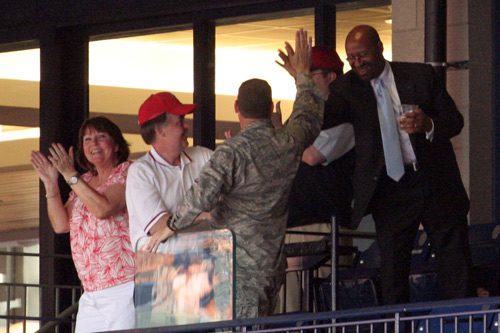
In case you missed Nathaniel's latest contribution to The Possible City earlier this week,
we'd like to announce it again, since no one else seems to be:
PHILADELPHIA'S POPULATION IS INCREASING.
With the US Census' release this week of the American Community Survey, most of the media coverage of it related to the finding that immigration is down. Given the climate of immigration
relations of the past three or so years, that is no surprise. But a simple sifting through the data shows something that here in Philadelphia we have not seen since
the immediate post-World War II boom, and which Mayor Nutter was hoping to achieve in his administration:
PHILADELPHIA'S POPULATION IS INCREASING.
As Nathaniel mentioned on Wednesday, it's important not to put too much stock into census estimates, because they are estimates. And there's a certain level of
validity to claims that the official census, every ten years, has too great a margin of error.
BUT. If the estimates that come out every year are good enough for alarmist news stories that Phoenix has surpassed us as fifth most populous city -- that oh
shucks, poor old helpless, broke down us, Philadelphia's in an endless drain -- then the census estimates which show that we've actually increased in
population (and not just via immigration) should be trumpeted, and trumpeted louder.
Again, Philadelphia's figures from 2005 to 2007, directly from the US Census web site:
Year | City population
2005 | 1,406,415
2006 | 1,448,394
2007 | 1,449,634 | | | |
The 2007 estimate has Phoenix at 1,513,777, which is still more than Philadelphia. Who cares. While there's no denying that Phoenix's population has verifiably
increased as with so many Sun Belt cities, it's also verifiably puffed up its population numbers -- as with so many Sun Belt cities -- by annexing nearby local
communities over the past several decades. That includes the current #4, Houston. In 2005, I compiled a table comparing the change in population and the change in
land area of 22 American cities. It is HERE. Between 1950 and 2000, Phoenix's total area increased by an
astonishing 2,677%, from 17 square miles to 475 in 2000. Now, in 2008, it's at 517. (Phoenix.gov.)
Again, WHO CARES. Philadelphians should care as much about Phoenix as Phoenix does about us. Actually, scratch that. With the amount of "authentic cheesesteak"
places in Phoenix, they clearly care more than we do.
What's important is that Philadelphia has appeared to reverse its population drain. And no doubt, when the US Census releases its 2010 findings, the official ones,
it will tell us what we already know: that Philadelphia has less people than it did in 2000. But suppose these estimates are accurate. Suppose the upward tick
continues. In 2020, suppose this rusty old city sees its first increase in 70 years. Wouldn't that be something?
In a news week that has included a severe financial crisis, the government's
proposed answer to it, and the ungodly murder of another police officer, by someone who should not have even been on the streets, it's high time we celebrate some
good news. And if Philly Skyline is the only place that's going to do it, so be it.
PHILADELPHIA'S POPULATION IS INCREASING.
It's all at the Census, go see for yourself,
HERE.
–B Love
|

25 September 08: Philly Skyline Book Review:
Vanished Gardens: Finding Nature in Philadelphia,
by Sharon White, University of Georgia Press, 2008
|
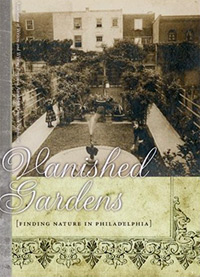 by Nathaniel Popkin
by Nathaniel Popkin
September 25, 2008
Here, in this lush, quiet, deeply observed and carefully researched book (winner of the Association of Writers and Writing Programs Award for Creative Nonfiction),
we are reminded of all that is heaving below our feet. In this city of discovery, the author Sharon White, a professor of writing at Temple University, sifts
through Philadelphia dirt, Philadelphia seed, bark, and leaf, through Philadelphia marsh, and river water, grass, and burrow, and finds the gardeners of our past,
people like John Haviland, Henry Pratt, Deborah Norris, William Logan, and John and William and Anne Bartram, and Mary Gibson Henry. And in so doing takes comfort
in her own life, with husband and son, in a city that felt at first foreign, hard, and unforgiving.
I have no connections here, no friends or relations, my history doesn't touch this creek or this river, their patch of ground in the mid-Atlantic.
But intrinsically she senses that in Philadelphia, it's our burden to own, to connect. The city obliges the instinct to explore, and the author carries forth:
But isn't it still a wilderness of sorts? The bones of the wilderness still there in the brooks flowing in pipes under the city, the soil that pokes up with its
own history of the old wilderness soil, rerouted, recycled elements . . . And if I could, if I were strong enough, rip the fabric of the city at the edge and peel
it away to rocks that were there all the time. Wilderness just under the surface. Breathing its clear breath right into my face.
White, a poet, underscores her book with a natural rhythm, and the sentences fall like drops of rain. She steps back and forth, into the shadows and out, out to
the heavens and into her flower boxes, into geological time -- and geological space -- and out into the contours of our memory. Much as Beth Kephart in
Flow, White
mixes carefully studied observations of our nature -- rivers, creeks, woodlands, and the human presence -- with the voices of people who came here, sowed seed,
explored, rotated crops, carved magic, public gardens, and fell deeply into the rhythmic trance of the land itself.
As much as Vanished Gardens makes a nice companion to Flow, and indeed to a range of wonderful new writing that grapples with this city's encounter
with its past,
it reminds me most of the poet Kathleen Norris' 1993 Dakota: A Spiritual Journey. In that book, as this, the author observes the seasons, tests religious
faith,
explores the contexts of place, and comes, finally, to acceptance and perhaps, contentment. Both authors use discreet essays to uncover emotional truth. And both
books are, indeed, personal spiritual journeys by outsiders, with the places emerging as surprisingly forceful, meaningful, and entirely captivating.
In White's narrative, this recognition comes as a rush, like an epiphany, or the prick of a thorn (the chapter is called "Rose"):
I want to be charmed by the city but I'm not. Not by the woman with the perky little dog who greets me on her travels, not by the man sleeping in the park as I run
several times past, his encampment a brown sheet, a brown paper bag, a shopping cart with a symbolic fan that's real, propped on its side, a few possessions near
his head, boots, a shirt -- by the third time around the baseball fields he's stretching, one arm help up to the sun. Not by the cluster of birds in the dead fruit
tree, starlings and sparrows and crows, companions in the morning that's heating up with each circle around the fields. Not by the man rousing himself on a bench
or the other adjusting his shoes near his feet, not by the handmade table propped by the Sisters behind their convent on two stumps, not by the single rose blooming
in their garden. Not by the falling leaves of the sycamores, crumpling in the dry heat, not by the fountain spewing silver water, not by the little boy learning to
walk right in front of our door, not by the blue jay calling in the morning or the fat spider strung up on the clematis and tomato on the deck. Not by the two
matching children with backpacks, both miniatures of their tall mother or the church smelling cool as I walk past up the street. Not by the word "lucky" scrawled
in a sidewalk, not by putting one foot and then another into the letters as I walk.
She gets it, this new city of hers, and there is joy, a kind of raw sensual pleasure in her discovery. There's a limit too -- I suspect to the memoir form more
than the author's own imagination. Some of my sensing of this limit is a response to the writing itself. There are too many sentences that feel like an
exhalation, and that default begins to feel manipulative. (It's something Norris mostly avoids in Dakota.) I'm being made to feel something, but what I'm
feeling too often is the lightness of the author's touch and not the brush of a leaf, the splash of water, the grief of loss.
But the trouble is in the medium. It's a memoir, which makes it ultimately all about the author. Kephart solves this problem by making the Schuylkill River her
main character; the river is both historical and contemporary, and all the old voices flash around it. That distance between author and subject allows for humor,
honesty, and anger. White, on the other hand, and aside from a few neighbors she mentions and others she talks to in passing, is the contemporary point of
reference in Vanished Gardens. It may have been ultimately more powerful, I think, to connect the treasure trove of past gardeners, with their unitary
Anglo-heritage, not just her own life but to the polyglot of real gardeners here, today. It would have been even more revealing. The reader certainly senses her
interest in this contemporary scene. Let's hope she's still finding joy in discovery, because there's a whole lot more to sift through.
–Nathaniel Popkin
nathaniel.popkin@gmail.com
For Nathaniel Popkin archives, please see HERE, or visit his web site HERE.
|

25 September 08: The 36th Street Bridge Song
(Feelin' Groovy)

In Philadelphia's Delaware River, the bridges across it are pretty straightforward, well used and well known: Tacony-Palmyra, Betsy Ross, Ben Franklin, Walt
Whitman. And oh, don't forget about the Delair railroad bridge. That's it, end of story.
Or is it?
Well . . . yes and no.
Philadelphia's Delaware River covers twenty-three shoreline miles, from the Poquessing Creek to the international airport. And indeed, those five bridges are the
ones leading into and out of Philadelphia. But in those same twenty-three miles, there is another bridge across the Delaware -- a hidden bridge, a Petty
bridge.

The island called Petty's is the 300 acre, triangular piece of private controversy nestled midstream in the Delaware, about halfway between the Ben Franklin and
Betsy Ross Bridges. It's relatively little known locally because it's been entirely private since the 1960s. The only people going there are employees and truckers.
Petty's Island -- technically Petty Island, according to the US Board on Geographic Names, but for our
purposes, the locally accepted Petty's Island -- has a long history, far longer than a man named Petty ever inhabited it. It has had several names: the
Lenapes' Shackamaxon Island (it is positioned in the river directly east of Fishtown, where William Penn's famous treaty with the Indians at Shackamaxon allegedly
happened), Aequikenaska from 17th century Swedes here before Penn, and Treaty Island from nostalgic industrialists in the mid-19th century, but the name we know it
by today stems from Philadelphia's early heyday: the American Revolution, when it was also placed into New Jersey's jurisdiction. The Quaker John Petty inherited
the island in 1732 from Thomas Fairman, who controlled the island at the time. It was under Petty's ownership when Philadelphia was the center of the American
Revolution, and its name has stuck ever since, retaining the handle in spite of the efforts to change it to Treaty Island in the 1850s. USHistory.org has more on
the early history of Petty's Island HERE, and Will Van Sant compiled a more recent
account for the Inquirer in 2001, archived at camdennewjersey.org HERE.
Petty's Island's history is equally as odd as it is long. It had a certain renown as a Quaker place of ill repute (it was far enough away from old Philadelphia's
elders and it was relatively lawless), it was the site of slave auctions, it was the site of duels, it was supposedly a landing place for Blackbeard the pirate,
and it was the site of unadulterated debauchery -- Party's Island, if you will. And, oddly, it took industry to refine Petty's Island. The Crew Levick
Company, an early gasoline company, had been on the island since at least 1906 (New Jersey State Treasurer's Report, 1907). Cities Service Company, a predecessor to
Citgo, purchased Crew Levick in 1916 (Citgo corporate
history) and has been there ever since.
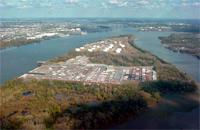 It's Citgo who owns Petty's Island now, using only a small portion of it for fuel storage, and leasing out space to Crowley Maritime Corporation, whose ships one
can see docked from Penn Treaty Park. The island's odd history continued into 2005, when it was a hot button issue in New Jersey's gubernatorial election. Citgo,
the large oil company, had volunteered the island for a natural preserve. Jon Corzine, the Democrat (usually the environmentalist's party of choice), claimed this was
suspect and that Citgo was trying to get out of costly remediation. Doug Forrester, the Republican, called this grandstanding and that Corzine was effectively going
to bat for Pennsauken's development of the island, led by powerful Pennsauken Democrat George Norcross. Pennsauken's development plan of choice at the time belonged
to Cherokee Investment Partners, who wanted to created 700 homes, a 250 room hotel and a golf course. (See the New York Times' 2005 series on this HERE and HERE.)
It's Citgo who owns Petty's Island now, using only a small portion of it for fuel storage, and leasing out space to Crowley Maritime Corporation, whose ships one
can see docked from Penn Treaty Park. The island's odd history continued into 2005, when it was a hot button issue in New Jersey's gubernatorial election. Citgo,
the large oil company, had volunteered the island for a natural preserve. Jon Corzine, the Democrat (usually the environmentalist's party of choice), claimed this was
suspect and that Citgo was trying to get out of costly remediation. Doug Forrester, the Republican, called this grandstanding and that Corzine was effectively going
to bat for Pennsauken's development of the island, led by powerful Pennsauken Democrat George Norcross. Pennsauken's development plan of choice at the time belonged
to Cherokee Investment Partners, who wanted to created 700 homes, a 250 room hotel and a golf course. (See the New York Times' 2005 series on this HERE and HERE.)
Well, none of those things has happened -- Cherokee's out, it's still no nature preserve, and Citgo still owns and operates the island -- and here we are on the
outside looking in. It might have been the feeling Citgo (Cities Service) had when it acquired Crew Levick, thinking there must be an easier way to and from
Camden/Pennsauken to the burgeoning oil industry on that island. So when it moved onto the island, it hired a company who knew a little about operating railroads
and building bridges: the Pennsylvania Railroad.
On April 23, 1917, Pennsauken Township authorized the construction by PRR of the first ever bridge to Petty's Island. (Fichter, Jack H, Our Pennsauken,
p 175, 1975.) Built across the back channel of the Delaware, it was a single-track railroad bridge and did not accommodate automobile traffic. Its location at
36th Street -- the border between Camden and Pennsauken -- was accommodating enough, though, having easy access to the industrial city to the south and the growing
township to the east.
With the main shipping channel of the river on the west side of the island, a bridge here did not need a high level. Its clearance was, and remains, 15' -- enough
for small boats to pass under, small boats like those docked at the Farragut Yacht Club in Camden.
The aerial photo, by Skyphotos and hosted at phillyh2o HERE,
shows a good overview of Petty's Island in 1967, with the main artery in the center of the island being a freight rail line. You can see the oil tankers on that
artery detailed in this 1940 aerial by Dallin Aerial Survey Company, at the excellent Hagley Library (Wilmington, DE) web site HERE.
The 36th Street Bridge, also known as the 'Camden and Petty's Island Bridge' -- continued as a single track railroad bridge until 1989, when Pennsauken authorized
its redecking and paving.

Hello lampposts. Whatcha knowin'? I've come to watch your oil goin'.
And so it is today, the 36th Street Bridge. Camden and Petty's Island Bridge, if you prefer. Only don't expect to just traipse over it and go for a nature walk on
the muddy banks of Petty's Island. 1. It's not a nature preserve and 2. it's still Citgo's island. You need permission from Citgo to be there, and there's a
guardhouse on the Camden/Pennsauken side of the bridge to see to it that you have it.
* * *
For a new mini-essay of photos of the Camden and Petty's Island Bridge (10 total), please click
HERE.
SPECIAL THANKS to Martha Cannon from the Pennsauken Free Public Library and John Adams from the Pennsauken Office of Planning and Zoning for their
assistance in this story.
For additional resources on Petty's Island, check out the following web sites:
• USHistory.org -- historic background on Petty's Island
• "How to Make History, the Easy Way" -- an analytic essay by Ron Gutkowski on
how to handle Petty's Island
• "Freedom Island" -- a proposal of active use for the island
• About Pennsauken -- a history of the township
• Pennsauken Green -- a study of Petty's Island prepared by the Delaware
Riverkeeper
• Sierra Activist -- a gallery of Petty's Island, including photos, active uses,
inactive uses and plans
–B Love
|
24 September 08: Rivers and rails
Bridges of the Delaware commentary from Steve Ives

Long before the advent of the car, these were the primary means of travel for people and goods across long distances. The Pennsylvania Railroad, The B & O and the
Union Pacific became the great channels of commerce in this country and they mimicked, and sometimes followed, the routes of The Ohio, The Delaware or The Hudson
Rivers around which the first great cities grew and prospered. Many of the great American cities of yesteryear achieved their status through the conspicuous
exploitation of these original highways.
Today, while still relevant, these original conduits are looked back on almost as romantic relics. The great rivers are no longer lined with smoke belching
foundries and teeming with barges and our railroads are no longer the glamorous means of intercity travel, mingling the masses that board at quaint countryside
sheds and alight in marvelous structures once considered the front doors of great cities. They're a part of our lives as city dwellers because they've always been
there and as long as the city remains, so shall they. One of their great contributions now, as they in some ways have been relegated to the background of everyday
life, is their value in the abstract and something wondrous often seems to stir in the imagination at the place where the river meets the rails.
In the case of Philadelphia, there are several places where this occurs, sometimes beautifully and sometimes painfully not. At the two locations where it occurs
over the Delaware, Philadelphia's original front door, the experience of looking out over the water and the city as you vault over the river present two very
different experiences that are both genuinely Philadelphian.
Coming from the Delair Bridge, which carries freight and Atlantic City trains from New Jersey to the Northeast Corridor mainline, one leaves the green scenery and
the occasional car dealership of Burlington County behind to enter Philadelphia. The experience of riding across the bridge can be fun if one allows it to be. The
scenery reminds you of another era - steel trusses along the sides, city skyline off in the distance, ships downriver. Take the ride on a foggy night and the
experience can be Noir-ish. It isn't sleek, it doesn't feel terribly modern but it feels right for a place like Philadelphia -- and then you reach the bottom.
Seemingly eternal stretches of junk cars. A mothballed power plant. I-95. Undeveloped real estate. Past this buffer you can see and sense the city beyond. The
atmosphere changes from end to end but there is time enough to watch the city emerge from behind the remnants of industry. Seeing it all below on either side, one
would hardly know a river is nearby but once the bridge is reached, it makes a bit of sense.
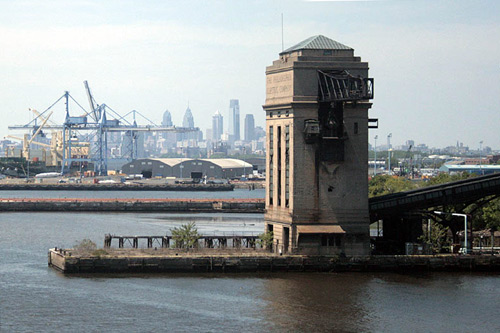
It's the industrial side of the river's legacy. The ungainly cogs that make a region go. Nothing here is pretty (not even the bridge) but it's all necessary. It's
the working river. You've come in through the service entrance.
A bit downriver, though, the experience is quite different. One neither emerges from green fields nor enters brown ones. Where at the Delair Bridge, giving a sense
of amazement or arrival probably never entered the minds of its designers (and why would it?), at the Ben Franklin Bridge, it seems to have at least been
considered.
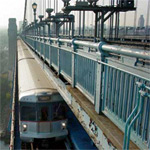 Where you can take Boston's Red Line across the Longfellow Bridge, or the D train from DUMBO to Canal Street across the Manhattan Bridge, PATCO across the Ben
Franklin is how one takes a flying leap across the river into the center of Philadelphia. Though similar to the Delair in the sense that the view is not totally
unobstructed, it brings one into the city in a different air. The city isn't a just out of reach destination -- it's in your face there. Just feet to the left,
cars and buses whiz by. Down below, Delaware Avenue and I-95 and The El all intersect with you. One feels a part of the blood flow of the city, moving straight to
the heart. The active uses of the river are neither distant nor abstract. Homes beckon from just beyond the water line. Boats docked beneath the bridge. Everything
is up close. One gets that feeling of entering right at the front door. This is the living river.
Where you can take Boston's Red Line across the Longfellow Bridge, or the D train from DUMBO to Canal Street across the Manhattan Bridge, PATCO across the Ben
Franklin is how one takes a flying leap across the river into the center of Philadelphia. Though similar to the Delair in the sense that the view is not totally
unobstructed, it brings one into the city in a different air. The city isn't a just out of reach destination -- it's in your face there. Just feet to the left,
cars and buses whiz by. Down below, Delaware Avenue and I-95 and The El all intersect with you. One feels a part of the blood flow of the city, moving straight to
the heart. The active uses of the river are neither distant nor abstract. Homes beckon from just beyond the water line. Boats docked beneath the bridge. Everything
is up close. One gets that feeling of entering right at the front door. This is the living river.
So what is the common factor between both of these experiences? It's at the river where it is the most exhilarating. It's only at the river where people get the
urge to crane their necks and press noses to the glass. And what makes these experiences truly Philadelphian? They both present this city's exasperating dual
nature. The experience of entering the city at the front door, over the Ben Franklin, feels proper. It's the right way to come into a place like this. There's
energy around and everything feels large. The experience at the Delair gives you the nitty gritty side, the obligatory, sometimes hidden parts of the city, the
inelegant facilities that make the pretty face possible.
The two experiences give you the two faces of The Delaware and Philadelphia as a whole. While driving your car across one of the bridges you may not be able to
devote enough time to looking directly beneath you and seeing how the city unfolds from the river's edge to the streets. You've got toll plazas and traffic circles
to worry about. The ability to gaze out a window and wonder has always been one of the great aspects of riding trains and coming in through one of these two
gateways gives you an opportunity to think about how the city has grown around the river.
–Steve Ives
phillytrax@aol.com
For more from Steve Ives, please see his archives HERE.
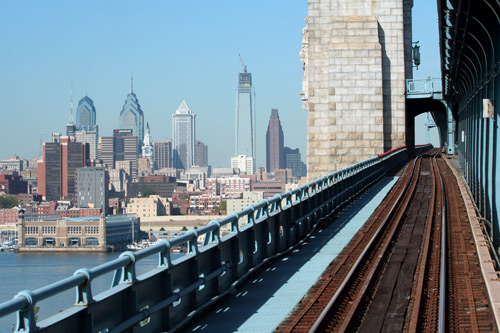
|
24 September 08: The Possible City:
The Opposite of Decline
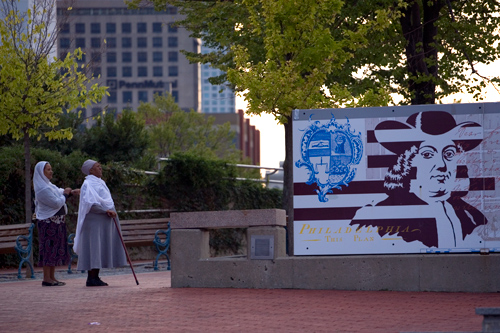
September 24, 2008
by Nathaniel Popkin
The US Census released immigration figures from the 2007 American Community Survey today. No surprise, given bolstered border patrols and the deflated economy.
(MSNBC: "America sees immigration slowdown.")
Foreign immigration is down, to half a million people last year. That's a significant decline, from 1.8 million in 2006, and 500,000 people short of what's been
since 1990 the yearly average of a million immigrants a year. Immigrants continued to populate certain cities, including this one, where the percentage of foreign
born jumped from 9 to 11.1% since the last official Census. As I've said before, that's the highest proportion here in nearly 60 years.
It's probably a good idea not to take these census estimates too seriously. According to previous estimates, the percentage of foreign born for people over 5 years
old was 11.1% in 2005 (another says 11.9%). It increased in 2006 to 11.6% and to 11.9% in 2007. Is that real? And what of the total population estimates
themselves, those used to rank cities by size? Previously, I've questioned their accuracy and other municipal governments have too, sometimes taking aggressive
action to force a recount. Cincinnati, St. Louis, and Boston have each done so.
That caveat aside (and there are others regarding the difficulty in ranking cities of different densities and the whole enterprise, that which seeks to reduce a
city to a statistic), the accounting released yesterday may give us reason to signal 2006 as the year Philadelphia stopped its long population decline (and 2005 as
the final bottoming out). Here's what I found in the Census' own American Community Survey:
Year | City population
2005 | 1,406,415
2006 | 1,448,394
2007 | 1,449,634 | | | |
That's a two year increase of 3%, significant given this long march of decline, and the first time in over six decades that the US Census reports Philadelphia's
population is growing. Assuming these estimates represent actual change, frankly it's time to breathe out. Growth presents an entirely different kind of
narrative.
Is Philadelphia growing? The 2010 census is likely to say no, that in comparison to the last counting, in 2000 (or 1999), Philadelphia has lost some 50,000 people.
While that's a significantly smaller decline than in previous decades (260,399 lost in the apocalyptic decade of the 1970s, for example), it still sounds to the
rest of the world like a city in descent. But if the real count is anything close to this 2007 estimate, or more, then we'll be confident in pronouncing a
tentative ascent. It's hard to know at this point. The least reliable indicator is my eyes and my experience in all corners of Philadelphia, which tells me,
indeed, the city is starting to grow again. There are better, such as the School District's census, a number that is significantly down (perhaps due in great
measure to the proliferation of charter schools).
I've been hitting the immigration bell quite a lot lately and that's because foreign immigration is how an old American city grows. My sense is that these better
looking population numbers represent a real change in that regard, and at almost 12% of the population there are enough immigrants here to attract more family
members and countrymen. There may be a multiplier effect at play. In any case, I leave you with this little historical chart of population and percent foreign
born.
| Year | City population | Percent foreign-born
1870 | 674,022 | 27.2%
1880 | 847,170 | 24.1%
1890 | 1,046,964 | 25.7%
1900 | 1,293,697 | 22.8%
1910 | 1,549,008 | 24.8%
1920 | 1,823,779 | 22%
1930 | 1,950,961 | 19.1%
1940 | 1,931,334 | 15.1%
1950 | 2,071,605 | 11.5%
1960 | 2,002,512 | 8.9%
1970 | 1,948,609 | 6.5%
1980 | 1,688,210 | 6.4%
1990 | 1,585,577 | 6.6%
2000 | 1,517,550 | 9%
* | * | *
2005 | 1,406,415 | 11.1%
2006 | 1,448,394 | 10.9%
2007 | 1,449,634 | 11.1%
| | | | | | | | | | | | | | | | | | |
SOURCE: US Census, US Census' American Community Survey
–Nathaniel Popkin
nathaniel.popkin@gmail.com
For more on The Possible City, please see HERE.
For Nathaniel Popkin archives, please see HERE, or visit his web site HERE.
|

23 September 08: Bridesburg to Betsy, or,
Yo holmes, to Delair!

That may be one of the worst headlines ever used on Philly Skyline. For that, I apologize. But for today's feature, to quote my recent Honey's Sit-n-Eat compatriot
Dice Raw (and his friend Talib Kweli on the hook), I will not apologize (I will not apologize).
We're back on that dynamic Delaware for the next stop, the double shot, the newest and the oldest bridges across that ocean-bound river in the city of Philadelphia:
Betsy Ross and Delair. It's true, that of the bridges spanning the Delaware River in Philadelphia, the oldest and the newest are right next to each other, closer
together than any of the bridges south of Trenton's trifecta and the Delaware Memorial twins.
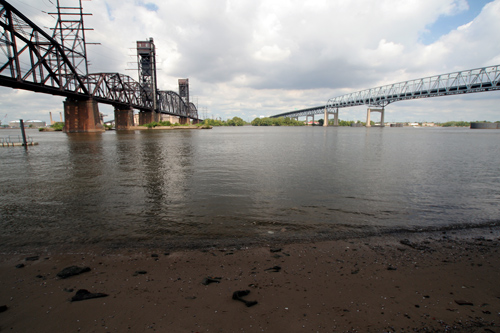
The Pennsylvania Railroad (PRR) ordered the construction of a bridge across the Delaware in 1895, the first ever crossing south of Trenton. The name Delair comes
from a section of Pennsauken Township, and to accommodate freight travel, a transfer was built here with the bridge, Delair Junction.
A railroad bridge directly across the Delaware was a sign of the powerful railroad times. It eliminated extra transfers of freight and it opened a direct line of
travel to the Jersey shore, including PRR's vacation community due east at Seaside Park and all points south -- Atlantic City, Ocean City and Cape May.
Trains departing from Broad Street Station would follow the main line to New York (modern day Northeast Corridor) and break from it toward Delair Bridge at Frankford
Junction. The 'Shore' signal tower still exists, visible from the el on the right side between Tioga and Erie-Torresdale. Mike Brotzman's signalbox.com has a
feature on this tower HERE.
The engineering of the Delair Bridge is a landmark in tidal crossings not only for its sandy foundation and length -- only one bridge in the country had longer
truss spans in 1895 -- but also for the fact it was movable. (Historian Justin Spivey prepared a paper on Delair for the Library of Congress in 2001 with a thorough
background. It is online HERE.) Since the Delaware River is tidal,
vessels heading upstream needed clearance; since heavy trains would need support, a high bridge was far more expensive than a low, movable bridge, even for the PRR.
As such, a rotating swing truss was positioned in the channel for the passage of ships, and as with the other bridges we've covered so far, marine vehicles took
priority over rail vehicles, so the bridge was constantly manned to coordinate between the pilots of the ships and the trains.
This swing bridge sufficed . . . for a while. World War II really boosted naval technology, and that meant larger vessels, including civilian vessels. A little past
noon on January 9, 1959, the swing became outmoded. The SS Marie Leonhardt, an oceangoing ship carrying iron ore to the new Fairless Works steel facility in
Morrisville, struck the bridge when the operator did not open it in time. A full account is available from the subsequent lawsuit between the ship and PRR, tried in
1963 the Third Circuit Court of Appeals, online HERE.
The opening of Fairless Works also necessitated the deepening of the Delaware's channel; in 1959, the US Army Corps of Engineers moved the channel from the swing
one span to the west, where the existing span was replaced by a lift that would rise 135'. (The bridge's existing clearance was 50'.) In addition to the added
vertical clearance, the lift span provided far more horizontal clearance than the narrow swing did. To compare the before-and-after conditions, have a look at an
1896 photo of the Delair Bridge soon after its opening on workshopoftheworld.com HERE, and an aerial from 1964 after the completion of the lift, on phillyh2o.org HERE.
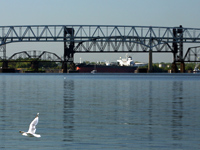 That lift bridge is in use today, same as it ever was. The photo at right (click to enlarge) shows the span lifted for the passing of a tanker heading toward Tioga
Terminal. The swing is no longer in use, but it's still there, making the Delair Bridge unique in that it has two movable spans in the same bridge.
That lift bridge is in use today, same as it ever was. The photo at right (click to enlarge) shows the span lifted for the passing of a tanker heading toward Tioga
Terminal. The swing is no longer in use, but it's still there, making the Delair Bridge unique in that it has two movable spans in the same bridge.
While the PRR is of course no longer around, a number of its ancestors, direct and indirect, certainly are. Conrail owns the Delair Bridge and leases its two
tracks: the northern one to New Jersey Transit for its 30th Street-Atlantic City line, the southern one to CSX and Norfolk Southern for freight travel.
New Jersey Transit's planned New York-Atlantic City express -- Atlantic City Express Service ("ACES" -- get it?) -- would also use the bridge in its route
from Penn Station to Atlantic City's terminal. The only stop it would make is in Newark; it only passes through Philly, switching off of the NEC line at Frankford
Junction. The transfer here is interesting: from NYC to Frankford, the train runs on an electric locomotive. From here to AC, it runs off of a diesel
locomotive. So, while there is an engine transfer, passengers will never have to leave the train. (They'll still have to go through Philly on an express route to AC
from NYC, but hey.)
As the passenger heads from Frankford toward the Delaware, out the left side of the train he will see a narrow body of water emptying into the river. It's the only
thing separating the Delair and Betsy Ross Bridges on the Philly side of the river. It wasn't always like this. Frankford Creek, which begins as Tookany Creek near
Arcadia University in Cheltenham and enters the city as Tacony Creek, where it continues through the park of the same name and the Juniata Golf Course on its way to
the Delaware as Frankford Creek in Bridesburg. (Makes sense, dunnit?) And while the trinomial trench has always deposited into the Delaware, it's only been
on the southern end of the neighborhood as long as the Betsy Ross Bridge.
In 1956, as part of a flood control project, Frankford Creek was rerouted from the northern end of Bridesburg to the southern end, the Bulletin calling it a
"snake that will be straightened." Adam Levine's excellent phillyh2o.org has a nice history (including a diagram printed by the Bulletin in 1949 of Creek pre- and
post-shift) HERE. Frankford Arsenal, on the north end of the former creek,
was originally called US Arsenal on Frankford Creek.
Around this same time, plans were being tossed around for a replacement to the aging, and low level, Tacony-Palmyra Bridge. And, as these were the 1950s, so too was
a vast network of expressways in and around Philly. The Crosstown (South Street) and Cobbs Creek Expressways are among the interstate designations (both I-695) that
fortunately never happened. A state route, the Pulaski Expressway (PA-90), would have followed Tacony/Frankford Creek, taking drivers from US-1, the Roosevelt
Expressway, to I-95 and the Delaware River at a new bridge, to be called -- like the existing railroad bridge -- the Delair Bridge. As always, Steve Anderson has a
thorough back story of the unbuilt Pulaski Highway at his web site phillyroads.com, HERE.
Meanwhile, I-95 was already under construction, and in 1969 one could travel from the new Scudder Falls bridge to Girard Avenue uninterrupted. Perhaps
unsurprisingly, both the Pulaski Expressway and the planned Delair Bridge were met with opponents in the neighborhoods they would affect. Protests from neighbors,
particularly along Adams Avenue, ultimately killed the Pulaski Expressway. With the Delair Bridge, though, residents of Bridesburg fearing an assault in traffic
simply delayed the construction, and then opening. Again, phillyroads.com has the historic overview HERE.
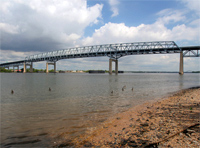 While the bridge was completed in 1974, it didn't actually open until 1976, by which time it had been renamed Betsy Ross Bridge, and during which year Bicentennial
pride and name association with (alleged) heroic flag seamstress Betsy Ross helped soften the blow of the bridge's opening in Bridesburg.
While the bridge was completed in 1974, it didn't actually open until 1976, by which time it had been renamed Betsy Ross Bridge, and during which year Bicentennial
pride and name association with (alleged) heroic flag seamstress Betsy Ross helped soften the blow of the bridge's opening in Bridesburg.
According to Steven Richman's The Bridges of New Jersey:
Opponents included Governor Milton Shapp of Pennsylvania and Mayor Frank L Rizzo of Philadelphia. On opening day, April 30, 1976, New Jersey Governor
Brendan Byrne faced about 150 demonstrators on the Pennsylvania side, who demanded barricades to protect Bridesburg.
Teresa Pyott, president of the Bridesburg Historical Society, recalls this with a laugh: "that was all really out of fear of traffic. But honestly, we all use it. I
think it's a wonderful bridge -- it drops me off in my neighborhood."
Of the delay in the opening, she tells a story: "Robert Hawthorne used to have a business down near the foot of the bridge, and he had a stable where he kept
horses. Before it opened, my daughter used to go riding with his kids across the bridge and ride along the shoreline in Jersey."
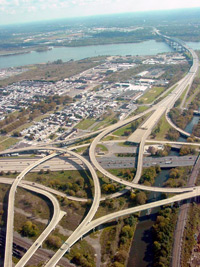 Just beyond that shoreline, the Betsy Ross Bridge deposited drivers onto US Route 130. In 1988, New Jersey built a connector road from the bridge to NJ-73,
effectively connecting Betsy Ross traffic with the Atlantic City Expressway, where 73 ends. That connector road has the designation NJ-90, a nod to PA-90, which was
never built. Actually, a small part of it was. When the ramps were finally built to the bridge in Bridesburg, so too were the beginnings of the ramps that would
carry drivers over I-95 to the Pulaski Expressway. Those humble(d) beginnings stand today, seen on the right side of 95 heading north under the Betsy Ross/Aramingo
interchange.
Just beyond that shoreline, the Betsy Ross Bridge deposited drivers onto US Route 130. In 1988, New Jersey built a connector road from the bridge to NJ-73,
effectively connecting Betsy Ross traffic with the Atlantic City Expressway, where 73 ends. That connector road has the designation NJ-90, a nod to PA-90, which was
never built. Actually, a small part of it was. When the ramps were finally built to the bridge in Bridesburg, so too were the beginnings of the ramps that would
carry drivers over I-95 to the Pulaski Expressway. Those humble(d) beginnings stand today, seen on the right side of 95 heading north under the Betsy Ross/Aramingo
interchange.
Under the operation of the Delaware River Port Authority, the Betsy Ross is, relatively
speaking, a lightly traveled bridge. Compared with the Ben Franklin (100,000) and Walt Whitman (150,000) bridges, the Betsy Ross' six lanes of traffic handle about
45,000 vehicles per day. The fare is the same for all three, though, $4, westbound only.
Of the four vehicular bridges across the Delaware in Philadelphia, the Betsy Ross is probably the easiest to access and easiest to drive. It's got a direct
connection to I-95, and there is rarely the congestion found on the Ben Franklin and Walt Whitman. And, it's the largest bridge in the country named for a woman.
Only a small railroad bridge in Iowa was existed with a woman's name prior to the opening of the Betsy Ross Bridge.
The Quaker Betsy Griscom eloped with the Episcopal John Ross, to avoid conflict within her church. They married in a tavern in Gloucester, and she became Betsy
Ross. To get there, they took the slow ferry from the old city down the river. If she'd only waited a couple hundred years, she could have fast-tracked across the
bridge bearing her name.
* * *
For a new mini-essay of photos of the Delair Bridge (18 total), please click
HERE.
For a new mini-essay of photos of the Betsy Ross Bridge (20 total), please click
HERE.
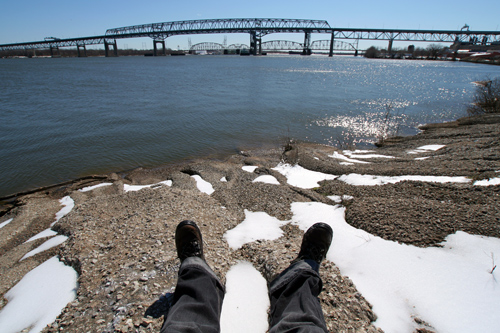
Winter of the Delaware: file photo from the Bridesburg banks of Philadelphia.
–B Love
|
22 September 08: Equinox mornin' lookin' up
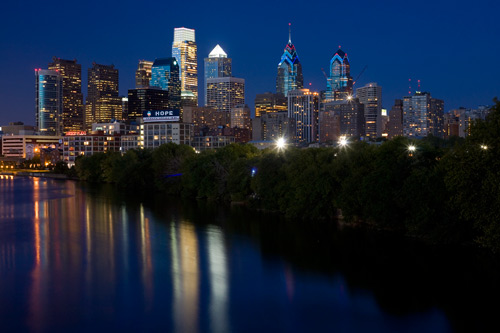
Well, it's official now: this Sunset on the Schuylkill marks the end of the Summer of the Delaware. But the Delaware's not over, and never will be over. That's an
amazing river we've got over on the eastern shore. It's the classic Paint Yourself Into A Corner situation . . . the room was summertime and the paint was the
Delaware. (What?) What I mean is: now that Philly Skyline has Delaware fever (sounds like a Joe Biden thing), we need more time to roll out our Big Ideas.
Actually what it needs is a new graphic. Or something.
What I'm saying is: the Delaware River series will continue, even where summer has not. In fact, the next bridges downstream are right around the corner, the corner
being 8 Mile Point in Pennsauken. Before that, though, a happy fun time look upward for yr Monday Morning, HOORAY!
* * *
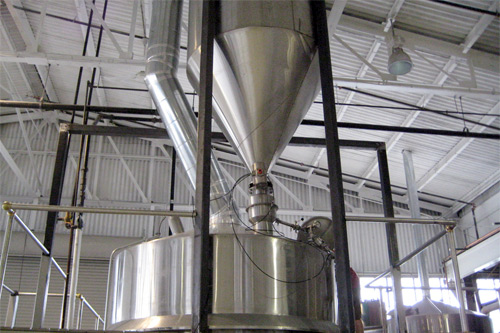
• DREW'S BREWS: I'd like to start this morning off with something tall and cold, a pint of good news for good brews. The
rumor that Yards is back in production? That ain't no rumor. City Paper's Drew Lazor got himself a tour of the new brewery on Delaware Ave that was so good it
couldn't wait for the next printed paper. An online exclusive is up on CP's web site HERE, with a wrap-up and a ton of photos of the process (including the one above). Great work Drew, and greater work Yards -- can't wait to see
the brewpub beer garden in action.
* * *
• THREE SEVENS ON SOUTH BROAD: Out on the construction front, one place I've just not passed in person in ages is Broad &
Fitzwater. Playing softball at Palumbo and eating breakfast at Morning Glory (both at 10th & Fitz) and living in G-Ho (21st & Fitz -- ran into my old neighbor and
he said the house I used to live in recently sold for $280K, which is a bona fide steal in the Ho, but which needs a ton of work) for so many years, Broad & Fitz is
a familiar corner. And considering how many Phillies games I go to, I've been no more than 20 feet below it at least a dozen times this summer. So, following the
advice of several emailers (thanks for those), I swung by it at street level, and hoowah, Dranoff is rocking and rolling there. The retooled 777 South Broad is a
handsome infill project, judging by the rendering, and the economic downturn and government bailout appear to (as yet) have no effect on this project, well under
way where not long ago there was a full row of bombed out rowhouses.
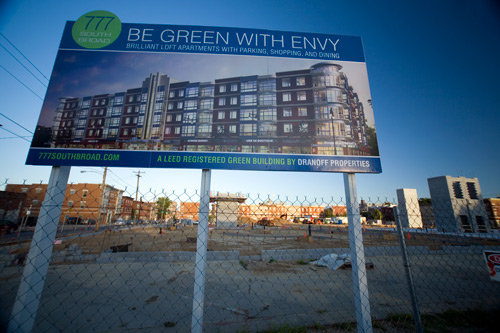
* * *
• CHOP CHOP CHOP: A whole new Medical District is on its way to having its own little skyline on the banks of the
Schuylkill. CHOP's new tower, seen here, is one of several planned buildings on Civic Center Boulevard. (If the collection of Penn's medical institutions there has
any decency, they'll rename that boulevard.) Next door, the Perelman Center is getting ready to open
soon.

* * *
 • UPDATE YOUR BOOKMARKS: Ladies and gentlemen, this young man is someone who chances are you already
know, but definitely will know soon. Greg Heller is a city planner working for the Delaware Valley Regional Planning Commission, he's an occasional contributor of
editorials at the Inquirer, and he's an Ed Bacon scholar. (Greg is writing Bacon's biography as we speak, with an expected publish date next year.) And now he is,
as they say, a blogger. Check out his Urban Direction HERE. • UPDATE YOUR BOOKMARKS: Ladies and gentlemen, this young man is someone who chances are you already
know, but definitely will know soon. Greg Heller is a city planner working for the Delaware Valley Regional Planning Commission, he's an occasional contributor of
editorials at the Inquirer, and he's an Ed Bacon scholar. (Greg is writing Bacon's biography as we speak, with an expected publish date next year.) And now he is,
as they say, a blogger. Check out his Urban Direction HERE.
* * *
• ANONYMOUS DRAW: Recall if you will earlier this month the announcement for the opening reception of
DRAW:Philadelphia. Myself, Sneha Patel and Ed Bronstein judged the competition whose theme was the skyline -- "to explore its ambiguities and
potentialities." As it was a drawing competition, it was open to loose interpretation. (Even the definition of "drawing" was openly interpreted.) Some were very
literal in their approach, one by Clem Cizewski and Kat Beitzel showing the skyline with American Commerce Center, Cira South and Mandeville Place. Others were
more abstract, including a multimedia piece by Lauren Powers and Sara Pettit showing a comical What-If with the worst case scenario of Unisys type signs. Others
still took the skyline in a different, spatial direction, plotting maps of shadows and reaches.
We pretty well agreed on the winner, a happily disheveled, hand drawn sketch by Amanda Li with lots of cranes. But after we'd voted and come to an agreement, I kept
going back to one piece. The drawing below -- submitted anonymously -- took me a while to get, but after I got it, I really got it. My interpretation is: it's a
cross section of the city, let's say following Ridge or Germantown Avenues, rising from sea level to the upper hills of Roxborough/Chestnut Hill, with an
exaggerated skyline massing and what are either oil derricks or elevated expressways. The bottom portion, though, took me a while, and was probably the reason I
didn't cast a higher vote. Where I originally thought it was some abstract cave or geologic massing I'd never seen, a simple tilt of my head revealed that it's a
map of the city, perfectly aligned with the cross section.
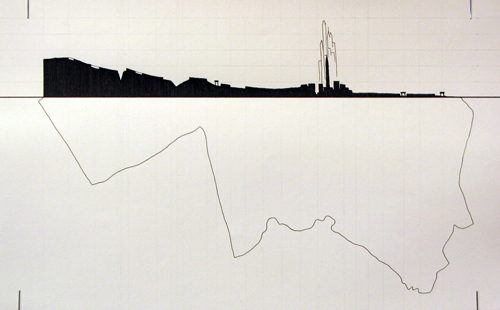
So to you, anonymous, I raise a toast: job well done. If you are the rightful artist of this drawing and would like proper credit, drop me a
line and I'll be happy to do that.
Meantime, the exhibition continues until the end of this month at the Center For Architecture, 1812 Arch Street. Waste no time, drop by and check it out. [Philadelphia CFA.]
(Also, a big thanks to Ryan Drummond for all of this.)
UPDATE: Well now that didn't take long at all. Kristen Suzda from the Art Museum Area writes:
I would like to claim credit for the skyline drawing on your website . . . I've been out of the country and unable to make it over [to CFA]. Thanks for the heads
up!
And thank you, Kristen, for the awesome drawing!
* * *
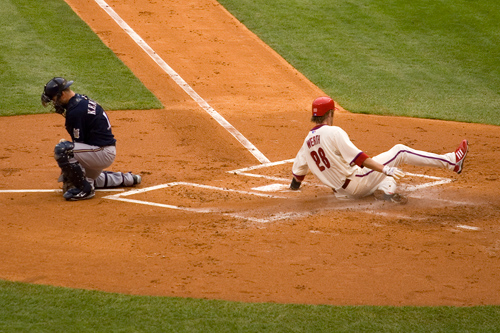
• SAFE IN FIRST PLACE: Don't look now, but the Phillies are twenty games over .500! That's just insane. Everyone is
feeling it -- Feliz, Ruiz, the MVPs, the bullpen, even Chase is starting to come back around. If we can just convince Pat Burrell that he's auditioning for next season's
paycheck, maybe we can even pull him out of his funk in time for the playoffs. Fall baseball is good, very very good.
As is fall in Philadelphia, Hall & Oates.
Welcome back, fall. It's a great time to be here, y'all.
–B Love
|
22 September 08: THANK YOU
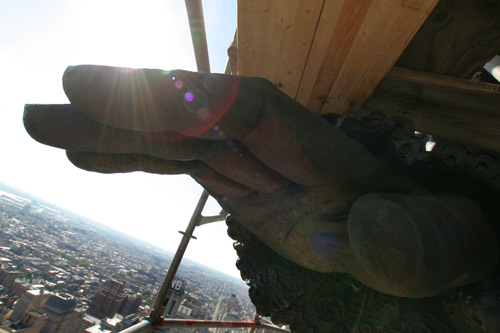
A big, huge, hearty thanks to everyone who came out to Johnny Brenda's last night to make What's Possible possible (including State Representative Mark B
Cohen, former mayoral candidate Sam Katz and especially JB's owner William Reed -- thanks a milliam, William).
A good time was had by all, a good discussion was held (if maybe a little short), and books were signed. If you were unable to attend, you can find a good deal of
Nathaniel's ideas and ideals in The Possible City, his second book, out now. Check your local bookstore, and check back here for future events.
UPDATE: Now with photographic evidence. Muchas gracias to Nathaniel's wife Rona Buchalter for having her camera along.
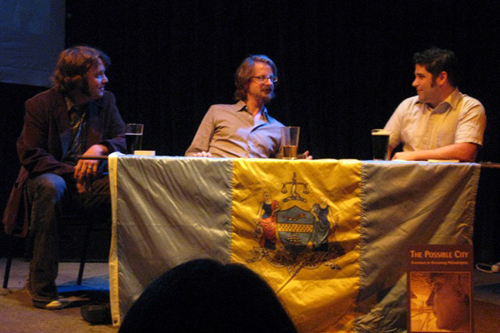
Possible participants: B Love, NR Popkin, City Paper's Brian Howard.
–B Love
|

19 September 08: The Possible City:
"To see something greater"
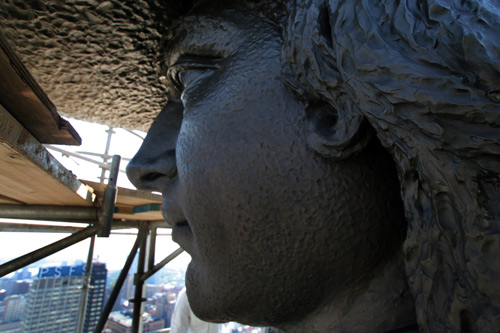
by Nathaniel Popkin
September 19, 2008
"He was quite a contradictory fellow," says Sam Katz, explaining his new-found fascination with William Penn. "We tend to think of him as the grandfather of
religious freedom, which he was, but he was also the largest private landholder in the world."
Penn was a slaveholder who granted broad freedoms, a benevolent dictator who formed one of the world's first democracies, a member of the English aristocracy who
continuously worked to undermine its authority, a pacifist who put down an Irish uprising, and whose status in the eyes of the King was derived from his father's
heroic service in war, and as Steve Conn, in Metropolitan Philadelphia, observes, simultaneously Philadelphia's first citizen and its first suburbanite.
And Katz, the businessman who would have been mayor, wants to tell the story. Last April, after renting Ric Burns' documentary history New York, Katz searched
for something similar on Philadelphia. He found instead Chicago: City of the Century, Las Vegas: An Unconventional City, and American Experience: New
Orleans. Now, after interviewing dozens of historians, journalists, and community leaders, and consuming about 200 books on the city's history, he's
transformed himself into the executive producer of what's tentatively titled The Remaking of America's First City: Philadelphia, an ambitious film and
multi-media project now in a developmental stage. (Disclosure: I'm part of the film-making team.)
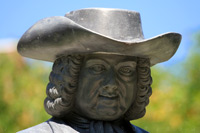 "For somebody who thought he knew a lot about Philadelphia," Katz explains, "there was a huge gap in my knowledge, roughly between the Revolution and the election
of Richardson Dilworth as mayor. I began to suspect that a lot of what Philadelphia was -- is, might be -- is rooted in things about which people know nothing .
. . Turns out I knew nothing about William Penn."
"For somebody who thought he knew a lot about Philadelphia," Katz explains, "there was a huge gap in my knowledge, roughly between the Revolution and the election
of Richardson Dilworth as mayor. I began to suspect that a lot of what Philadelphia was -- is, might be -- is rooted in things about which people know nothing .
. . Turns out I knew nothing about William Penn."
Katz tells me that Penn never thought of himself as a Philadelphian. "He occupied our river banks 17 months to three years. That's it. The rest is predicated
on mythology," particularly Penn's dealings with the Lenape. In great contrast to other European settlers, including Lord Baltimore to the south and the Puritans
to the north, Penn sought a different way. Instead of stealing, he purchased land; instead of subjugation, he legislated and enforced religious freedom. But, as
Katz instructs, the Lenape he encountered were substantially (50-90%) weakened by disease wrought by the Swedes, Dutch, and other English settlers. Friendship
was therefore easy.
Later, when Penn's sons and his secretary James Logan enforced their land title, in a maneuver that led to the infamous "walking purchase," it was the Lenape who
said, "William Penn would never have treated us this way." A myth was born.
 It's a myth that defines us, not only as a city but a nation. Penn, according to Thomas Jefferson, was "the greatest law giver." A student of Locke and a
prolific writer, it was Penn who first gave us our national framework of government, declarations of personal and religious freedom, trial-by-jury, and free
elections.
It's a myth that defines us, not only as a city but a nation. Penn, according to Thomas Jefferson, was "the greatest law giver." A student of Locke and a
prolific writer, it was Penn who first gave us our national framework of government, declarations of personal and religious freedom, trial-by-jury, and free
elections.
But Penn was also a land speculator, who sought to prove his political points by selling building lots to like-minded people. This combination of idealism and
commerce, particularly, is what fascinates Katz. "First and foremost he left a place founded on a set of principals and ideals -- maybe even more so than the
1775-76 revolutionaries -- a welcoming place of practical government and democracy." In Philadelphia, he sought to correct the mistakes of London, 40% of which
had burned in the fire of 1666, and Paris, perhaps the most rapacious -- and filthy -- city of the time, by planning a modern city.
The west bank of the Delaware was the key to his colony's fortune. There lay the possible city. "He had the ability to look at something and to see something
greater for the future," notes Katz, wondering if one of the elements of the Philadelphia story is that "we haven't had enough of those kinds of people."
–Nathaniel Popkin
nathaniel.popkin@gmail.com
* * *
 The grandfather of religious freedom in America, the man who withheld personal freedom. William Penn's contradictions didn't so much doom Philadelphia
from its onset as they complicated it. Over the past year, Nathaniel Popkin has examined these complexities with an optimistic eye but with at least one foot in
reality in a column called The Possible City. These columns have transcended into something larger, a book
of the same name, the second from Popkin the author, published by Camino
Books. (It also features six of my photos.)
The grandfather of religious freedom in America, the man who withheld personal freedom. William Penn's contradictions didn't so much doom Philadelphia
from its onset as they complicated it. Over the past year, Nathaniel Popkin has examined these complexities with an optimistic eye but with at least one foot in
reality in a column called The Possible City. These columns have transcended into something larger, a book
of the same name, the second from Popkin the author, published by Camino
Books. (It also features six of my photos.)
This Sunday, September 21st, is a special date to us: It marks the first anniversary of The Possible City column. It marks the last day of summer 2008, the Summer
of the Delaware, the series which has explored (and will continue to explore beyond summer) the river which Penn sailed up to find the land deeded him from the
King of England. And, it marks the official launch of that book, so we'd love to have you come celebrate with us.
What's Possible is the theme of the evening -- appropriately, a mostly optimistic but somewhat realistic discussion of, well, The Possible City. Join us
for a salon in the mold of our previous For The Curious events, with Nathaniel, myself and City Paper editor-in-chief Brian Howard. We'll talk a little about how
the column and book came to be and a lot about Philadelphia, Penn's holy experiment, our possible city.
What's Possible: Sunday, September 21st at Johnny Brenda's, Frankford & Girard in Fishtown. Our
start time is eyeballed for 8 o'clock, but we realize there is a 4:15 Steelers and Eagles game, so we'll save the best part of the conversation until at least
8:30, giving everyone plenty of time to make it to JB's. Best of all, the event is FREE.
We'll also have books for sale, so if you haven't bought yours yet, you can pick one up at JB's. City Paper excerpted The Possible City last week, online
HERE.
–B Love
|
19 September 08: And now, Tacony-Palmyra

Time . . . keeps flowing like a river . . . on and on . . . to the seeeea.
Tell you what man, I'll be the first to admit that I am a damned fool to have thought that I could fit every subject on a Delaware River checklist that seems to
grow every day into one summer. The individual bridges alone are enormous projects (I never expected to get 1,200 words out of the two Burlington-Bristol bridges), and
there's about a million other topics worth covering. The nip in the air the last few days (and the nip that will stay in the air over the next few days --
seriously, what an amazing forecast) indicates that summer is done with us. Time and the tidal Delaware wait for no man, after all.
But Philly Skyline's not quite done with the Delaware, though. We're Atlantic Ocean bound, so we'll cross these bridges, or at least pass under them, as we get to
them.
And what better bridge to continue that journey than the next one down the river, the first one in the city of Philadelphia heading downstream: the Tacony-Palmyra
Bridge.
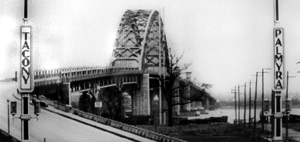 This historic photo, from the interpretive center at the Palmyra Cove Nature Park, shows the bridge as
it was when it opened in 1929. It doesn't look very different today, but I'll bet some art deco collector is drooling somewhere over those signs. The nature park
has several miles of hiking, including along the Delaware shoreline, where one can wade (or swim, if you're daring) and take in an unmatched view of the
bridge.
This historic photo, from the interpretive center at the Palmyra Cove Nature Park, shows the bridge as
it was when it opened in 1929. It doesn't look very different today, but I'll bet some art deco collector is drooling somewhere over those signs. The nature park
has several miles of hiking, including along the Delaware shoreline, where one can wade (or swim, if you're daring) and take in an unmatched view of the
bridge.
The Tacony-Palmyra Bridge is perhaps Philadelphia's first real benchmark in the recognition of automobile travel. It predates the Schuylkill Expressway, I-95 and
the auto dependent suburbs they created. The Ben Franklin Bridge does that too, sure,
but its location and size indicate a greater need to bring central Philadelphia and Camden together. Eight miles upstream, Tacony-Palmyra was the first one
after that bridge opened, bringing together a bustling, industrial Tacony neighborhood with New Jersey and all shore points east.
The bridge, like many of the tidal Delaware bridges, replaced a ferry company at the same location. Interestingly, the bridge was planned to touch down in
Riverton, just upstream, but its residents protested and the Tacony-Palmyra Ferry effectively became the Tacony-Palmyra Bridge. The Palmyra ferry terminal, at the
foot of Cinnaminson Avenue, is now a community center with tennis courts and a swimming pool. On the PA side, the land on both sides of the bridge is currently
vacant, but the Delaware River City Corporation has planned Lardner's Point Park,
named for the water department's historic pumping station on the south side of the bridge.
The Tacony-Palmyra Ferry Company had been operating only seven years when it ran its last crossing on August 14, 1929, the day the bridge opened to much pomp and
circumstance. There was bunting, there were boats (one which brought Mayor Harry Mackey to the event -- Philly History has some great photos of this HERE), and there were cars revved up and raring to go. And go they did. Thousands of people crossed the bridge on its opening day -- during
which access was free -- because they could. Collection of the original 35¢ toll began at 12:30 that night, and 90 minutes later the first accident occurred.
Tacony Civic Association president Louis Iatarola wrote a great history of the bridge for the Tacony Historical Society HERE.
Tacony-Palmyra's design can be considered a result of the success of the Ben Franklin Bridge. The latter opened in 1926, the pride of its engineer Ralph Modjeski
and his consulting architect Paul Cret. Tacony-Palmyra was to be the first of several additional bridges erected across the Delaware based on the New Jersey Act
of 1925, and Modjeski's firm was chosen. Working again with Cret, Modjeski delivered the steel arch bridge in 1927, and construction began in 1928. Construction
lasted less than 18 months and was completed under budget.
 Tacony-Palmyra is also a working bridge. While the 173' arch is so iconic it's used by both Palmyra
borough and Tacony civic (logos at left), it has a drawbridge that is equally as important. The
double leaf bascule opens from two counterbalanced sides to allow passage of tall vessels up and down the river. As we mentioned with the
Burlington-Bristol, the bridge is manned 24/7, as the bridge must open when a ship comes, rush hour traffic or not. The drawbridge occurs in the span
immediately to the east of the arch span, giving the Tacony-Palmyra the slightly off-centered appearance it has if you look at it from mid-river.
Tacony-Palmyra is also a working bridge. While the 173' arch is so iconic it's used by both Palmyra
borough and Tacony civic (logos at left), it has a drawbridge that is equally as important. The
double leaf bascule opens from two counterbalanced sides to allow passage of tall vessels up and down the river. As we mentioned with the
Burlington-Bristol, the bridge is manned 24/7, as the bridge must open when a ship comes, rush hour traffic or not. The drawbridge occurs in the span
immediately to the east of the arch span, giving the Tacony-Palmyra the slightly off-centered appearance it has if you look at it from mid-river.
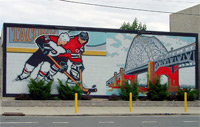 The name "Tacony-Palmyra" is nearly as adopted as the arch of the bridge (seen here in a mural depicting, appropriately, a hockey game between the Flyers and
Devils, and also in the arch at Tacony Billiards). The Tacony-Palmyra Drive-In, which opened in 1957
and closed in 1986, made its way back into the news earlier this year. Now the site of the Tacony-Palmyra Flea Market, Palmyra borough initiated a cleanup of the
60 acre site in anticipation of redevelopment. Imagine their surprise when they discovered 180 live shells left over by the US Army, which had a proving ground
here during World War II. Sam Wood wrote a great article for the Inquirer in April, HERE. The shells have been removed, and the flea market reopened in August.
The name "Tacony-Palmyra" is nearly as adopted as the arch of the bridge (seen here in a mural depicting, appropriately, a hockey game between the Flyers and
Devils, and also in the arch at Tacony Billiards). The Tacony-Palmyra Drive-In, which opened in 1957
and closed in 1986, made its way back into the news earlier this year. Now the site of the Tacony-Palmyra Flea Market, Palmyra borough initiated a cleanup of the
60 acre site in anticipation of redevelopment. Imagine their surprise when they discovered 180 live shells left over by the US Army, which had a proving ground
here during World War II. Sam Wood wrote a great article for the Inquirer in April, HERE. The shells have been removed, and the flea market reopened in August.
The bridge itself, despite carrying the smallest capacity -- three lanes -- of the four vehicular Delaware bridges in Philadelphia, is still well used, more so
since DRPA raised the tolls on the nearby Betsy Ross and Ben Franklin Bridges. Operated by the Burlington County Bridge Commission (BCBC), Tacony-Palmyra has a $2 toll, half
that of DRPA's bridges. As mentioned above, the original toll was 35¢, but that actually dropped twice, first in 1948 to 25¢, when the bridge was
purchased from the Tacony-Palmyra Bridge Company by the BCBC, and again to 5¢ in 1955 when the bonds were paid off. This earned the bridge the nickname the
"Nickel Bridge".
That same year, according to Steve Anderson's PhillyRoads.com, the Army Corps
of Engineers declared the bridge "'obsolete' and a hazard for navigation" with a recommendation for replacing it with a high-level bridge (i.e. one without a
drawbridge, so as to not impede vehicular or river traffic). That didn't happen, but BCBC did raise the tolls to begin necessary improvements.
In 1928, the last full year of the Tacony-Palmyra Ferry, it carried 508,000 passengers. The first full year of the Tacony-Palmyra Bridge saw 1.2 million
passengers. Nowadays, it averages a whopping 26 million a year. (Iatarola.)
All this even without an interchange with I-95, which came through nearly 40 years after the bridge's construction and whose closest exits are over a mile in
either direction.
Interestingly, in light of last year's bridge collapse in Minneapolis, the US Department of Transportation's National Bridge Inventory grabbed the attention of many governors and media outlets. Tacony-Palmyra was rated as structurally deficient. The
engineer Modjeski declared at the 1929 opening, "This is a bridge, with proper maintenance, that we hope will last one-hundred years." (This passage is from a
story called Bridge Lessons, by Harry Silcox and Jack McCarthy for the Northeast Times, online HERE.) We're eighty years out now, but in spite of the 'structurally deficient' tag, BCBC's maintenance ensures that the last 20 shouldn't be
a problem to meet Modjeski's prediction.
For a new mini-essay of photos of the Tacony-Palmyra Bridge (24 total), please click
HERE.
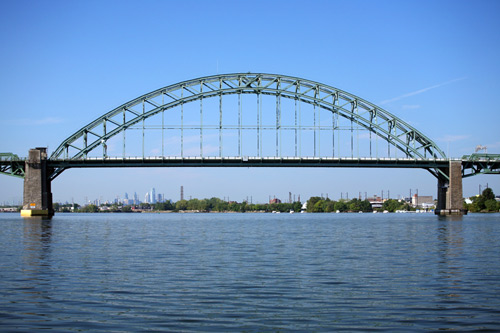
–B Love
|
18 September 08: The Possible City
Dwindling/rekindling possibilities?
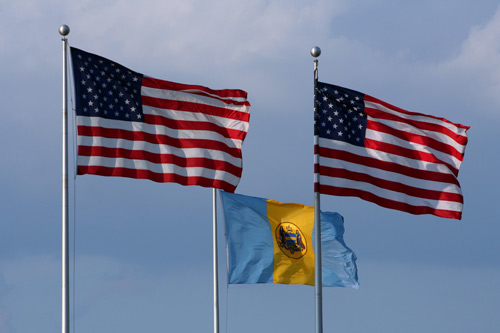
by Nathaniel Popkin
September 18, 2008
Ed. note: Nathaniel has an excellent, intriguing piece on Nicaragua for Naked City in the new City Paper. It is online HERE. Also, in this piece, he mentions The Skinny -- its information will be
updated and added onto in the coming days.
The ripping apart and reassembling has been going for as long as some people can remember, and still it goes. Bainbridge where I live is sliced open; a line of
black asphalt snakes through the neighborhood like a cold alpine creek and men heave and dig and fire generators and wicked two-stroke engines. The noise
endemic, the air, even on a day like today so shatteringly crisp is cluttered with particulates and low, near the earth itself -- baby carriage height -- it must
be toxic.
The creek snakes south, but just north the surgery on South Street, the cheeky red light district, is near completion. I don't complain about this project. The
sidewalk's smooth now and the lighting better and it's been followed by the opening of a handful of decent new stores. My only concern is the glaring one
illuminated by Tom Ferrick in one of his last Inquirer columns: there are too few African-Americans working on this union job. Meanwhile at 6th and South
artists complete the new mural dedicated to African-American firemen (really a nod to the neighborhood's powerful black history). The failure to integrate our
trade unions can't be overstated.
But so many have indeed participated on a scale not seen in at least a generation. Imagine the human energy spent remaking this city these past ten years.
Imagine the will. The Skinny lists 24 major projects "complete." Of course that's
merely a hint of what's taken place. On certain blocks across the city every rowhouse has been renovated, updated, improved. Vast infrastructure has been
replaced, universities and other institutions expanded, the airport and other transit nodes expanded, parks replenished.
All this, the rush of it, the filth and sweat (never mind what's getting built), combined with the torrid energy of the foreign born, is dazzling, and it feels
good. And now, says, Inga Saffron in last Friday's Inquirer, facing down financial crisis and burst bubble, "Philadelphia's greatest real-estate boom in
half a century has come and gone."
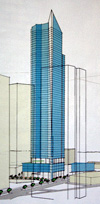 What's now: one by one the best proposals have fallen away. A few, some gems, some duds -- the Parkway Central Library expansion, the Barnes, Penn's eastward
expansion, the Philadelphia Museum, the expansion of the Convention Center, a casino or two -- are likely to happen. That's critical, of course. The end isn't
near. Our imaginations will keep fire.
What's now: one by one the best proposals have fallen away. A few, some gems, some duds -- the Parkway Central Library expansion, the Barnes, Penn's eastward
expansion, the Philadelphia Museum, the expansion of the Convention Center, a casino or two -- are likely to happen. That's critical, of course. The end isn't
near. Our imaginations will keep fire.
But the brilliant momentum that spawned The Skinny, and the joy of watching the list grow, day after day for four years, is gone. (It may be useful to expand the
vision of the Skinny somewhat to include more infrastructure projects, more schools -- the School District has an ambitious capital program -- more institutional
projects large and small. Paying attention to these smaller-scale investments, in part to ensure their quality, is a way to keep us engaged in the constant
reweaving of the urban fabric.) The near-term possibilities, certainly, have dwindled.
We are fortunate to have strong leadership (imagine if it had only accompanied the boom). And yet there is worry, and there ought to be. The current financial
crisis acts like an Internet virus, and its still spreading. Pain is coming, perhaps well beyond the red ink already encountered by the city's budget office.
Present levels of immigration seem unsustainable, and violent crime persists. Though the police department reports a 17% drop in shootings this year from last,
armed men still retain a hold on certain vast neighborhoods. Writing in this month's Harper's, where he is contributing editor, novelist (and former
captain of the Penn basketball team) John Edgar Wideman says of this persistent state, which he likens to the state of war:
a war keeping people locked down at home, no foreign enemies to defeat, just ourselves defeated by fear of one another, a war incarcerating all of us in killing
fields . . .
Indeed, it's begun to feel like someone else's freedom -- one gun a month just won't do -- has become our urban prison, and Philadelphia a hellfire for a couple
thousand victims a year.
If homicide had already undercut the boom, imagine how it plays in a downturn, with a shrinking tax base, a federal government distracted by crisis and war, and
deepening poverty. In his forthcoming magisterial work on civil rights in the north, Sweet Land of Liberty (Random House, on sale November 4) Penn historian Tom
Sugrue reminds us of just how this went down in the 1970s:
Cities struggled mightily with declining tax revenue at the same time that poverty was rising and infrastructure was decaying. One important stopgap had been the
infusion of federal funding to city government between the New Deal and the early 1970s. But beginning in the 1970s, as central cities grew blacker and poorer,
the federal government began a steady withdrawal of urban funding.
All this is the source of our present trouble -- and quite eerily what we're about to face again. But there are significant differences, not the least of which
is a possible Obama presidency. Whereas the anti-urban Jimmy Carter became a Democratic president at a similar moment in the period Sugrue describes, the Chicago
senator is an urbanite, who lives in what might be Spruce Hill, Hyde Park. His platform promises a national director of urban affairs and an infrastructure
investment fund; critically, he seems to understand that cities are particularly important to the wealth and health of a nation.
High gas prices and global warming have already elevated the status of public transit; infrastructure is therefore already getting a boost. It may be crumbling,
but at least now we're paying attention. And so long as Governor Rendell can protect SEPTA's dedicated funding, the agency will continue to aspire to something
greater. With only two years to go in the Rendell administration, his leadership is key to surviving this current crisis. Can the governor, that greatest of all
Philly cheerleaders, immunize us from decline? No, but smart investment by Harrisburg in transformative projects can propel the city, just as, as a matter of
psychology, the convention center and all the hotels did in the 1990s. These two years are certainly a last great hope for progressive, urban-oriented
policy-making.
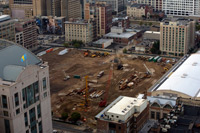 There is, of course, a massive, transformative state-funded project awaiting, the convention center expansion. Unfortunately, it seems both out of the hands of
the governor and the mayor, and not just for this, I am worried. Might that project, already well over budget and behind schedule, collapse? Mind you, I am
conjecturing, so don't panic; on the other hand, can't you just picture that vast empty lot, now freed of its interesting, panoptic architecture, a giant black
top? It's Saffron's worst nightmare -- and ours. Mayor Nutter ought to get control of the project, which now seems to operate in a black hole, illuminate the
process and assert real management (much as he inserted the city back into the casino process). I'm not opposed to convention centers -- my sense is that most
anything that makes a city feel open to the rest of the world is valuable -- but I haven't confidence in this project. Its loss would be wounding.
There is, of course, a massive, transformative state-funded project awaiting, the convention center expansion. Unfortunately, it seems both out of the hands of
the governor and the mayor, and not just for this, I am worried. Might that project, already well over budget and behind schedule, collapse? Mind you, I am
conjecturing, so don't panic; on the other hand, can't you just picture that vast empty lot, now freed of its interesting, panoptic architecture, a giant black
top? It's Saffron's worst nightmare -- and ours. Mayor Nutter ought to get control of the project, which now seems to operate in a black hole, illuminate the
process and assert real management (much as he inserted the city back into the casino process). I'm not opposed to convention centers -- my sense is that most
anything that makes a city feel open to the rest of the world is valuable -- but I haven't confidence in this project. Its loss would be wounding.
Post-boom, the administration will want to pay more attention to the educational and medical institutions -- the "Eds and Meds" as former LaSalle University
professor Rick Geruson called them in the early 1990s -- that form the backbone of the city's economy. Several of those institutions will continue expanding,
with some intent on also improving the neighborhoods where they are located. Because there is already momentum these nodes might be useful magnets for more
intensive planning and investment on the part of the administration. An Eds and Meds -- and some now ad arts and culture -- strategy will help make the
investment of scarce resources resonate. Related, I might seek alternative ways to go about neighborhood investment. Historic preservation is at present an
under-utilized tool (indeed, the opposite, historic destruction, seems to prevail); the Preservation Alliance would like to commence a preservation plan for the
entire city. It ought to be funded, turning, at long last, our architectural heritage into real city-wide potential.
At the same time, progressive, contemporary architecture will need life support during a downturn. Why not initiate a design-build competition on some piece of
open, but central land (perhaps one of our parking lot entrepreneurs would make a donation)? Chicago, with its fortunes teetering the early 1990s, did so; a new
Chicago school was born. (And residential architecture there avoided the reactionary pitfall we're forced to look at everyday.)
Perhaps the greatest loss in downturn is the feeling of moving ever forward. Men and women in hardhats amplify this city's resilience. It feels like a fight
back. Lose them, and? Historian Shan Holt, now the director of the Sandy Spring Museum in Maryland, lends us another way to think about it. She says
Philadelphia's historic strength and source of its contemporary energy is how the city performs as a Petri dish, an R&D center at the street level. This, more
than giant projects like Comcast Center, is the source of our present optimism. So many of us are engaged in so many kinds of vital initiatives; here is the
energy to propel us forward. Let's keep experimenting.
–Nathaniel Popkin
nathaniel.popkin@gmail.com
For more on The Possible City, please see HERE.
For Nathaniel Popkin archives, please see HERE, or visit his web site HERE.
|

18 September 08: 10 Ritt/z-Carlton, &c.

A new look at The Two . . . it's about time! What we have here are the two active construction sites actively chronicled by this active construction site.
10 Rittenhouse Square is now a force on the skyline in the southwestern clustering of Center City. It can now be seen from Citizens
Bank Park, West Philly and the Delaware River. The T-shape of the complex project is now especially noticeable from Rittenhouse Square (the park). The
cantilevering over the Alison Building is now being built out. The tower is at about 27 of its 33 stories.
Meanwhile, construction at the Residences at the Ritz-Carlton is winding down. The crane is being dismantled, and before long, there
will be a ribbon cutting ceremony, people will move in, and The Triune, the last
vestige of the Meridian tower, will be taken out of its box.
For your photographic enjoyment, please have a look at . . .
10 Rittenhouse Square
§
Residences at the Ritz-Carlton
Relatedly:
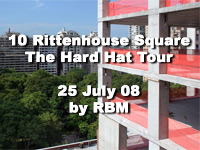 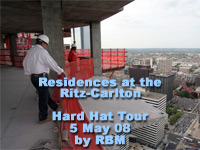
* * *
Two other quick notes of construction things . . . Waterfront Square, the gated luxury community between vacant piers next to a probable slots barn and a half
sunken ferry, is close to three-fifths finished now. The Reef, the shortest and squattest of WFS's five towers, is topped out and occupies the beige space in
your view out the right side of the El heading east and you're stopped at the Spring Garden station. This view is a bit broader, from 33 stories above 12th &
Market. I actually like this picture more for the green representation of the Port Richmond Conrail Yards and the curve of the river heading toward the Betsy Ross
Bridge.
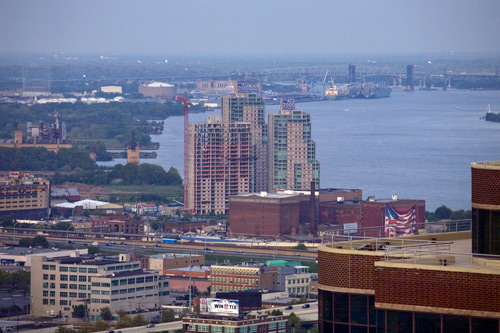
While we're up here, let's pan over to the Convention Center expansion's progress . . .
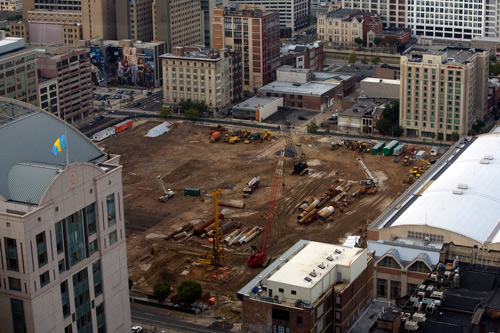
Pipes! Lots of pipes!
* * *
Finally, while we're on all this construction talk, I'd like to take a trip back to the biggest construction project in my time here. I took over 4,000 photos of
Comcast Center while it was under construction, and now that it's open, it's everywhere. (Except on a lot of skyline graphics -- the next round of skyline graphic
reviews is coming soon.)
I bought a Canon EOS 5D about two months ago, but for some odd reason, I didn't start shooting with it until I had an assignment that necessitated it -- at
Comcast Center. I thought it was kind of funny, or maybe appropriate, that the very first thing I set out to shoot with a new camera was the building I'd taken
more photos of than any single subject in my life. After two photos, one of my makeover-needing office and one of my cat, the third photo I took was this one . .
.
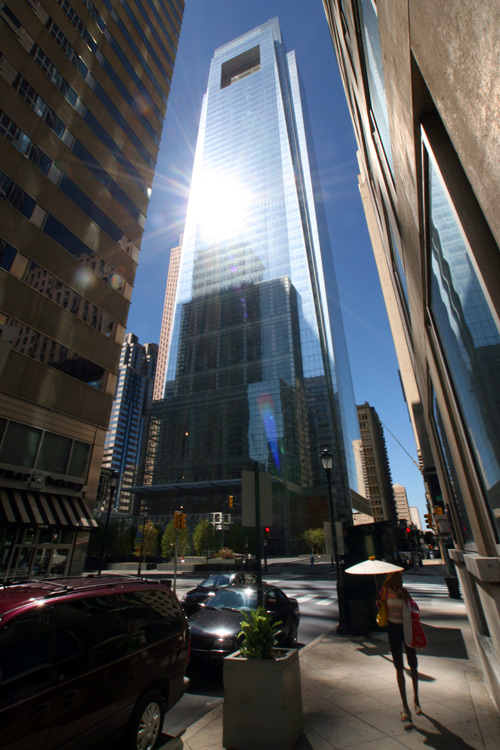
Using the 5D was instant love, instant kicking myself for having waited so long. Now I'm all about the f2.8 24-70 lens, and after that a zoom lens of sports
photographer caliber.
Anyway, Comcast Center. By now, everyone has seen the video screen. Most people either know someone who works in the building or has visited someone there, so
we've heard about the views and the silly dress code. But I suppose people are still deciding whether to check out the pricey Table 31 and its less pricey, and
less good, Plaza Café. People including Craig LaBan, whose Sunday review was a meat lover's fantasy. Giving the steakhouse bistro an excellent three bells,
the food scribe says . . .
[The "tomahawk" chop, a] 24-ounce, $68 mallet of prime rib steak is so Jurassically huge on its foot-long bone, it's already become the city's
ultimate bombastic chop. And it is a genuine carnivore's trophy. I sank my teeth deep into that thick pillow of steer and my eyes flickered as the peppery spark
of its heat-charred crust gave way to a gush of juice. The savor of richly marbled beef rang in my head like a bell (bong, bong, bong . . .).
That description rings in my head like a bell (or three bells, bong bong bong) and makes my mouth need a towel. I had the veal porterhouse on my last
visit, and it was fantastic. I've had the bar options at Table 31's bar, and they've been pretty decent. But I've been repeatedly disappointed with the Plaza
Café. While it's obviously one of the city's
greatest outdoor dining spaces -- maybe even the best, considering the fountain, constant activity and bonus for skyscraper geeks -- the food itself has been
inconsistent at best, and the beer list makes me shudder. The only 'standard' beer they offer is the Jimmy Buffett beer I wouldn't even approach with irony.
(Though I've been on a shiraz and malbec kick, I do like the merlot at the Plaza -- from Maule Valley, Chile.) The lobster roll I had was at once a
hit-and-miss sandwich. The salad itself, though a little light on lobster, was quite good, but the roll it was served on was borderline stale. The sushi is a
constant hit -- a spicy tuna and mango roll with blackened sesame is 3-for-3. But dessert? The "strawberries and creme" we ordered was served like an old Jell-o
parfait, which is quite a misnomer if you have issues with gelatin. The service has been good, though, and though the inconsistency has been disappointing, the
place itself will bring me back. The main Table 31 restaurant,
though . . . three bells is no exaggeration. The place is the real deal.
Philly Skyline Comcast Skyline, take us home with a double shot.

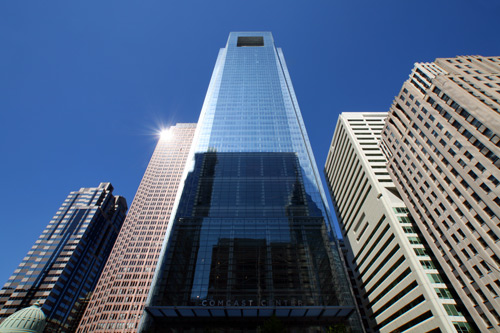
–B Love
|
17 September 08: Philly Skyline Time Warp: two weeks ago, or,
Put away the old September blues
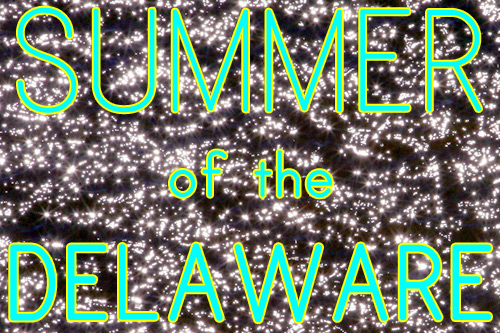
WARNING: THIS IS A HIPPIE DIPPIE POST. If you are offended by things like curse words and recreational drugs, best to just skip it.
* * *
On Saturday morning, the sixth of September, I woke up with a colossal rock & roll hangover. The previous night at high tide on the Delaware River, my mind was
officially blown.
My first concert was in November 1992, when my mom allowed her 16 year old son to go to a co-headlining show at Penn State's Rec Hall with Public
Enemy and Ice-T. House of Pain opened. (This was after she didn't allow me to go to a Red Hot Chili Peppers show the year before with Smashing
Pumpkins and Pearl Jam opening. I played Sonic the Hedgehog with Gish blasting in protest.)
In the sixteen years and second half of my life since, I've been to a million shows -- Radiohead in NYC just before 9/11, Roger Waters in Toronto, Phish at an air
force base in Maine and an indian reservation in Florida, Pulp in a forest in England, a reggae festival at Red Rocks in Colorado. In the past eight years, the
quarter of my life spent in Philadelphia, I've been to at least 68 concerts whose ticket stubs I've kept, and at least that many where there were no tickets,
just covers at the door. The Roots on the night I moved here, Wilco at the Tower, Dylan and Willie at Campbell's Field, Phish at the Spectrum, an old school
hip-hop night with Rakim, EPMD, Biz Markie, Run DMC,
Big Daddy Kane, Doug E Fresh and Slick Rick at the Electric Factory the weekend of the 2002 NBA All Star Game. Hall & Oates at the Mann, Ween at Penn's Landing, G
Love at the TLA, The Capitol Years, Mazarin, The A-Sides, Dr Dog, The War on Drugs, Spank Rock, at the Khyber, North Star, Troc, the Church, Mill Creek, Johnny
Brenda's. Philly has more great live music than anyone could fully see.
But none of it was on the level of the My Morning Jacket show, a show I walked to from my house the evening of September 5th at Festival Pier. (I had edited my
photos from it and was writing a review of it when my Technology Timeout set in.)
In my concert going days, there has never been a more complete show. MMJ knew exactly what they were doing. There was no opener -- the night was theirs. It was
hot and humid -- the show was on the River, with a steady River breeze. They were touring Evil Urges, their incredible new album -- it was more incredible
live.
 It began with that familiar buildup before the band walks onstage, but this anxious buildup was colored with a killer sunset behind the stage, beyond 95, beyond
the skyline. At its peak pink, MMJ walks out and lashes right into Anytime. It's on now, no turning back. Aluminum Park, Off the Record, Evil Urges. Everyone in
the place -- including the Flyers' Jeff Carter, Riley Cote and Scottie Upshall (check The 700 Level for that story) -- is in tune. Everyone, it seems, except for the people who are talking. Talking talking talking. Dude you
spent 40 bucks on this show too, why are you going to talk over it? And when the band plays louder, you talk louder. Why are you doing this? (If you've managed to
obtain an audio copy of the concert, listen to din of the people talking at the beginning of Dondante, for example.)
It began with that familiar buildup before the band walks onstage, but this anxious buildup was colored with a killer sunset behind the stage, beyond 95, beyond
the skyline. At its peak pink, MMJ walks out and lashes right into Anytime. It's on now, no turning back. Aluminum Park, Off the Record, Evil Urges. Everyone in
the place -- including the Flyers' Jeff Carter, Riley Cote and Scottie Upshall (check The 700 Level for that story) -- is in tune. Everyone, it seems, except for the people who are talking. Talking talking talking. Dude you
spent 40 bucks on this show too, why are you going to talk over it? And when the band plays louder, you talk louder. Why are you doing this? (If you've managed to
obtain an audio copy of the concert, listen to din of the people talking at the beginning of Dondante, for example.)
After catching a buzz and catching a Golden groove, I had to move away from this insanity, this talking during a concert, and get into my own Thing. I wanted to
be amazed by I'm Amazed. I figured that since I was on the Delaware River, I'd go to the River and find my Thing there. Only at Festival Pier, you cannot
get to the River. Liability, schmiability. There is a chain link fence and, how emblematic, a guardrail along the outer edges of the pier. But you can't
even get to them -- the vendors are set up such that you can't go to the river's edge, and where there are gaps between the cheesesteak and ice cream vendors,
there are bike rack barriers Independence National Historical Park would be proud of. The river, and big boats, and the Ben Franklin Bridge, they're all out
there, on the other side of all this crap and people in yellow shirts making sure your crazy ass doesn't want to get a closer look at them.
 But never mind all that. My Morning Jacket was not about to go down with my gripey ship, my landlocked ship; they were going to pull me up out of it. Did they
ever. Where the song War Begun is more pretty than loud, it got pretty loud pretty quickly, and the pretty stage lights got pretty powerful, and that took it into
the next level. Only there were no levels. Every single song, spanning their extensive catalog, just kept rising above the last song. Dondante, Gideon, Lay Low,
Mahgeetah, BREAK. Where the band gets a pee break, the fans get a break to soak in what has just happened, what's just exploded in front of their face. And then
comes the encore . . .
But never mind all that. My Morning Jacket was not about to go down with my gripey ship, my landlocked ship; they were going to pull me up out of it. Did they
ever. Where the song War Begun is more pretty than loud, it got pretty loud pretty quickly, and the pretty stage lights got pretty powerful, and that took it into
the next level. Only there were no levels. Every single song, spanning their extensive catalog, just kept rising above the last song. Dondante, Gideon, Lay Low,
Mahgeetah, BREAK. Where the band gets a pee break, the fans get a break to soak in what has just happened, what's just exploded in front of their face. And then
comes the encore . . .
I finally found my Thing, at the wordless chorus of Wordless Chorus. I saw a dad dancing with his two children, a little boy and little girl not more than 7
or 8, raising their arms and singing "ahhhhhhhhhh, ahhhh ahhhhhhhhhh." I don't have kids, but this moved me. And then I lost track of this American beautifulness
with the goofiness of Highly Suspicious. I don't understand why so many people dislike this song; it's as though a band's songs can't be actual fun, that the fun
must be implied, interpreted, or derived from them. Can't take a song with the line "peanut butter pudding surprise" seriously, now can we? I think it's
why so many people hate Ween. Clearly I disagree. I think Highly Suspicious maybe is a sort of in-joke, and if you get it, it's great. "I'm hiiiiiiiiigh .
. ." (catch that?) "hiiighly suspicious of you." And like everything else they've played, it's even better live. Then the epic Cobra, from the Chocolate and
Ice EP.
Then it got even better.

If Evil Urges is a 55 minute, 39 second symphony, its crescendo is no more brilliant than its last two songs, Smokin' From Shootin' and Touch Me I'm Going
to Scream Pt 2, each one its own mini-symphony with its own crescendo, the classic quiet-to-loud rock & roll buildup that's been done since before Stairway to
Heaven, before A Day in the Life. And again: they're better live. Only here, with these two songs, MMJ took assists from outside forces to blow the whole thing
open, to make a mockery of "reality" at Delaware & Spring Garden.
As the "diii-stance" bridge of Smokin' From Shootin' was taking off, the Camden Riversharks got in on the act, setting off a fireworks display that could not have
possibly been choreographed. Could it? As if the pyrotechnics over the Ben Franklin Bridge were not enough, the transition into Touch Me 2 brought the hot,
tiring, overstimulated crowd a cool, refreshing, welcome rain. The band's light guy pointed the stage lights up into the rain, highlighting this shower of
madness.
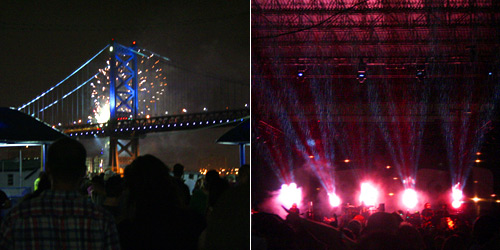
And then Run Thru, the signature, the anthem. And finally, the exclamation point, the dénouement, the noontime nugget, One Big
Holiday.
At this point, I didn't know what to say. Wading through the empty plastic Miller Lite bottles that I sure hope Penn's Landing Corp or Live Nation or whoever will
be recycling, I ran into Jake and Sarah, and I didn't know what to say. Walking with Steve and Afee, and Scott and Allie to the Druid's Keep for a post-show
cooldown, I didn't know what to say. I think I probably mustered a "holy shit." And to my man Buzz and his wife, and of course to Dan in Chestnut Hill -- I still
don't know what to say.
At a lot of recent concerts, I've felt too old for the large crowds, too old to be inhaling clouds of second hand cigarette smoke. At 32, maybe I am too
adult to gush about live music, too responsible to smoke a joint in public, too old to leave anywhere with my ears ringing. Yo man. FUNK DAT.
This night with the band from Louisville, Kentucky on the Delaware River, in the last days of the Summer of the Delaware River, was one for the ages. Such a
night. Sweet confusion under the moonlight. It was what it was, and what it was was phenomenal. The best concert ever seen in Philadelphia.
Coming back out for the encore, singer Jim James said to the Phila-del-PHI-a crowd, broadcast on live radio on XPN (yet sadly not archived there -- I'd
wager a guess that if you google "mmj festival pier" you'll come across a bootleg of it), "thank you so much, you guys know how to show us an old fashioned good
time. We appreciate it, we really do. It means a lot, we love coming back here every fucking time. You know how to bring the fun here, you know how to have a good
fucking time . . . and that's what we're here for, right?"
Thank You Too!
* * *
I took a handful of photos at the show, too. I was shooting in ISO 1600 (it was nighttime and Live Nation isn't about to let anyone bring in a tripod), so they're
a little noisy, but I'm mostly happy with how they look. They're also wallpaper sized, so if you'd like some Philly Skyline MMJ Skylines, please click the photo
below.
–B Love
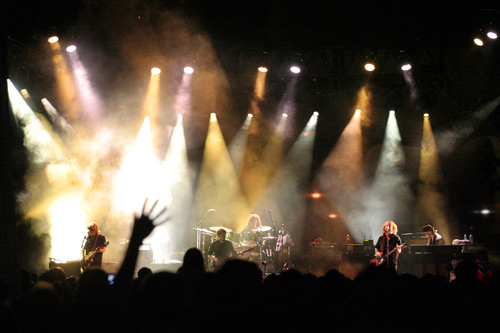
|
17 September 08: Ode to Ryan Howard
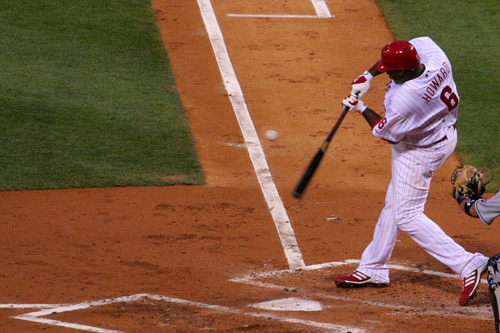
Cool mornings and hot coffee, how I love thee. You remind me of September, fall approaching, the playoffs in sight.
If Phillies baseball happens in October --
they're back in first, not even worried about the wild card -- it will be because of Ryan Howard. Moyer, Myers, Hamels, Romero, Lidge, even Madson . . . they've
all pitched excellently down the stretch. Rollins and Werth have picked up struggling Utley and Burrell. (Jeez Pat . . . 0 for 5 with five strikeouts and 4 LOB?
Ouch.) Victorino continues to solidly contribute. Even Chooch has kicked it up a gear into the homestretch.
But RyHo . . . unbelievable. My man was 4-for-5 in a crucial game, with a two-run blast in the eighth to put the Phils ahead for good. Brad Lidge tossed in a
little drama in the ninth to make it exciting, and at the end of the night the Phils were back in first place. I'd like to personally dedicate Howard's 45th
homerun to the punk kid at Penn's Landing who last night shouted "Phillies suck" at me as my dear friend Conor and I walked by en route to smoking the finest
cigar this side of Nicaragua. (Thanks for that, Nathaniel.)
Seriously: Ryan Howard is, like he did in 2006, carrying the Phils down the stretch. His 45 homeruns are eight better than the next best in all Major League
Baseball, and his 136 RBIs are 22 better than the next best in the National League, the third baseman of the chokingest bunch of chokers whose stadium is suitably
located in Queens.
We forgive the fielding moments and we don't care about the strikeouts. Just keep doing what you're doing, big guy.
Ryan Howard, you are the motherfucking man.
–B Love
|

16 September 08: Greetings from a broad
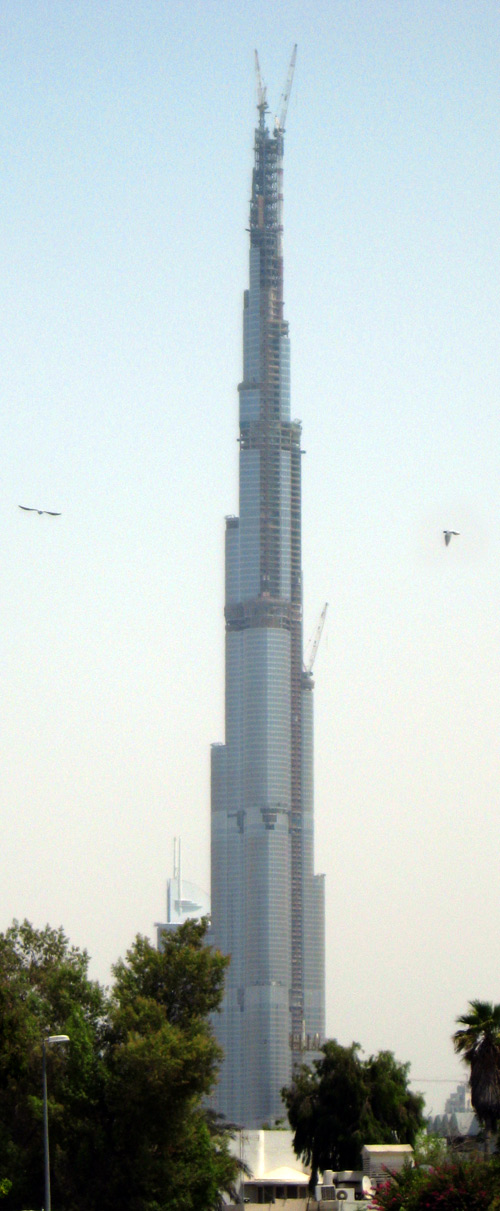
The Burj don't budge.
Still under construction, Burj Dubai has been the world's tallest building for over a year already. It surpassed Taipei 101 in July
2007, and expects to open in September 2009. Its height is being kept a secret, but when it is complete it will be the tallest structure ever built by
man. Estimated at 818 meters, or 2,683 feet, it would take nearly three Comcast Centers stacked high to reach the height of the Burj.
The building, the pride of the largest of the United Arab Emirates and 'icon of the new Middle East', was designed by Skidmore Owings & Merrill
(famous worldwide for New York's Lever House, Chicago's Sears Tower, Shanghai's Jin Mao and loads of others, and in Philly for the Spectrum and PNC
Bank Center) and is being built by Turner Construction (Cira Centre, Murano, The Linc).
This excellent photo was submitted by old friend and Royersford native Jessica Babin, who resides in Dubai. Thanks, Jessy.
Learn more about Burj Dubai at its official web site HERE or a thorough fan site HERE.
–B Love
|
16 September 08: For the Birds
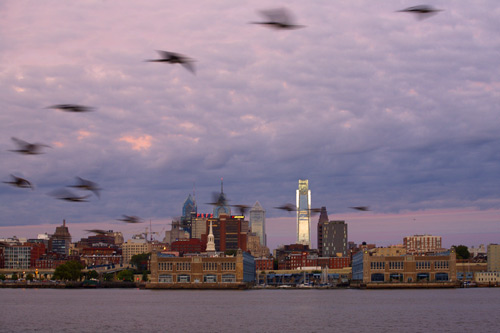
Eagles fans (especially Donovan McNabb's biggest supporters), you have nothing to be ashamed about in the loss to the Cowboys last night. Well, unless
you're a Sean Considine fan, and chances are you're not. That dude is terrible, and what's worse is that he's Brian Dawkins' top backup, and Dawkins
was exposed (as old). But Donovan (in spite of some bad late passes) and Brian Westbrook (in spite of a fumble that wasn't all his fault) and DeSean
Jackson (in spite of that stupid, and hilarious, toss of the TD ball) all looked phenomenal. Chris Gocong and Quintin Mikell looked surprisingly good.
Asante Samuel and Sheldon Brown looked unsurprisingly good.
All in all, a good show by the Eagles in Dallas. But not, however, a good show by ESPN. I mean, everyone knows how awful and self serving ESPN's
football announcers are -- seeing Tony Kornheiser in HD makes me slam my eyes shut and hearing him drone on and on about nothing at all makes me slam
my head into a wall -- but the way they were on the Cowboys' jocks, especially Jerry Jones, all night was just disgusting. Even Ron Jaworksi . . .
hey Jaws, you're allowed to show a little homerism, maybe stick up for your boys when B-West gets his face jerked around three times and the
refs don't call it. Sheesh.
Ah well. Steelers are here next Sunday, so rather than speak of NFL allegiances, Philly Skyline wishes to invite you to What's Possible, our
celebration that evening at Johnny Brenda's of the release of Nathaniel Popkin's second book, The Possible City.
Like the Eagles game, the Philly Skyline V-formation Skyline above is also of the close-but-no-cigar variety. It was taken this morning across the
Delaware River in Camden, where I expected to watch a spectacular sunrise behind me reflected off the skyline in front of me. Leaving the house at 6,
it showed signs of promise, magenta patches hanging on a navy blue canvas; but as dawn lit up, the colors mostly gave way to grays. But hey, these
geese were unfeathered. Er, unfettered.
–B Love
|
|






